#modern arnis
Text
I scored my first goal in floorball!
#positive things#I became one of the 3days a week sport junkies#don't ask how that happened Indon't know#balintawak arnis#modern arnis#and floorball
1 note
·
View note
Text
side eyeing anyone saying the barnes celebrate xmas....
#personcole#espec if they transplant modern comercialized xmas onto the fcking early 20th century 😭#like at least understand the historic context#bucky is jewish stop letting the mcu erase arnie 😭#steve is right there
17 notes
·
View notes
Text
Im not sure if i should draw my funger sona (its just me) or draw some of the modern au i was talking about with my friend
4 notes
·
View notes
Text
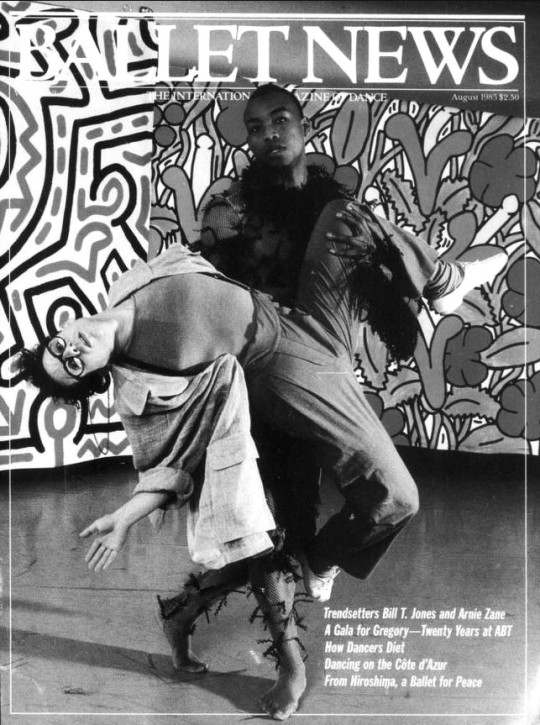
Post-Modernist dancers Bill T. Jones and Arnie Zane with a backdrop by Keith Haring on the cover of Ballet News, August 1985.
#bill t. jones#arnie zane#dance#dancers#male dancers#post-modernism#keith haring#ballet news#magazine covers#80s#lgbtq#lgbtq history#went down a rabbit hole today. they were partners in business and in life until arnie passed in 1988 but their dance company is still going#strong under jones' direction. jones is an absolutely magnetic speaker there are vids on yt where he talks about his thought process#for his choreographies and also different interviews and talking about arnie and he's just so well spoken his every word carries weight#he seems a genuine and profound human being
2 notes
·
View notes
Photo
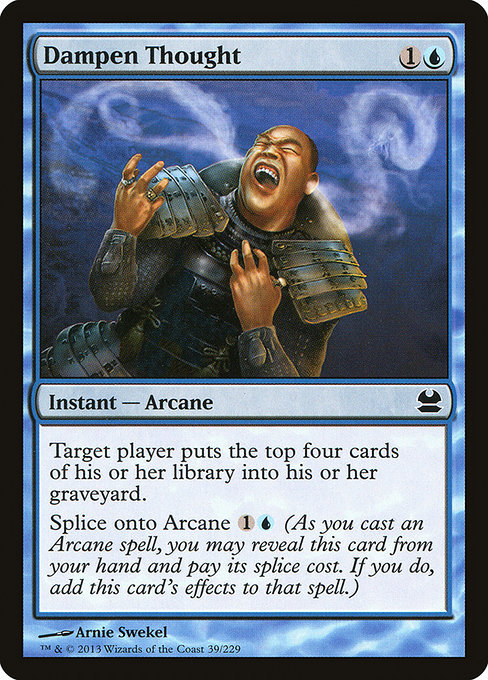
Dampen Thought
Artist: Arnie Swekel
TCG Player Link
Scryfall Link
EDHREC Link
17 notes
·
View notes
Text

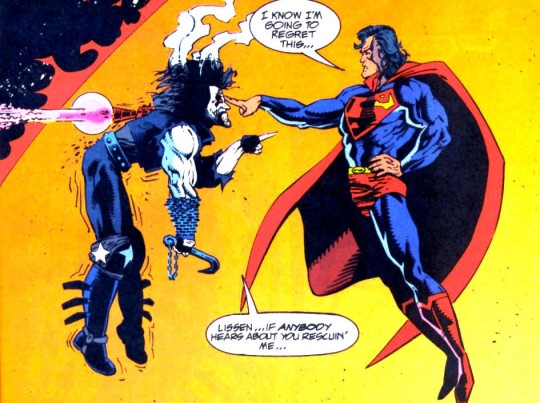
Superman and Lobo by Arnie Jorgensen
11 notes
·
View notes
Text
would your muse be a fan of moth daddy the band?
#i thought i asked this already but apparently it didn't post lmao#lennon & arnie are#modern moth daddy definitely played at coachella#work blogging
5 notes
·
View notes
Text
ToA Fic Recs!!!
Tag List: @itscharliebabey
ASK AND YOU SHALL RECEIVE!
I probably forgot a LOT but these are the ones I tracked down via bookmarks and frantic searches upon realizing they Were Not bookmarked rip 😔
AND ALL ORGANIZED!!!! :DDD
OneShots
Apollo & His Kids
A Heart Heavy With Memories by @summerbummin
After reclaiming his godhood, Apollo visits his children often, and on one of those visits he tells them about their mortal parents. He shows them memories of their time together. And ends up reminiscing a little more than he bargained for.
How I Met Your Mother(s and Fathers) by NebuchadnezzarII
Around the Cabin Seven table, Apollo tells each of his six children how he met their parents.
Through The Son's Eyes by @literallyjusttoa
A journey through Asclepius' relationship with his dad, from Ancient Greece to modern day.
demand nothing less (than transformation) by tissuebocks
Dad is quiet for a moment, stroking her hair. Then, with a surge of his usual flamboyant excitement: “At what time is your date?”
Kayla blinks. She pulls back a little to look at Dad. He’s still a little blurry from the tears, but she feels much calmer now. “He’s picking me up at six. …Why?”
Dad’s eyes—cobalt blue—sparkle. Literally. “We’re going to dress you to the nines.”
(or: apollo loves his daughter. he also loves fashion. even better is when the two intersect.)
@tsarinatorment
Can't Take My Eyes Off You
Naomi Solace is performing at a black tie event, and neither her son nor his boyfriend know much about formalwear.
Day 2: Black Tie Event
Fatal Flaw
Every demigod had one, and every demigod had their trial where they had to face it head on and hope they had the strength to defeat it before it defeated them.
Day 24: Injuries Beyond Healing
A Right To Emotions
Apollo had abandoned his son when he needed him, and the worst thing was that he’d never realised until Nico told him.
Day 30: Forgiveness In A New Day
Childhood, Or A Lack Thereof
Demigods grow up too fast.
Day 23: How long does youth last for?
Memories of Sunflowers
He first met his dad in a field of sunflowers.
Day 2: Alone in a Sunflower Field
Shuttered Heart
Apollo loves fiercely and his losses hit all the harder for it. It's a trait his children inherit.
Daughter of Archery
If there’s one thing Kayla knows, it’s archery.
Day 17: Perfection Is A Must
Apollo & Meg
Movie Night by @falconfrost
Meg and Apollo attend a midnight horror movie showing. Everyone likes clowns, right?
yesteryear by @m-arnie-xx
yesteryear (noun) — last year or the recent past, especially as nostalgically recalled; often a period in the past with a set of values or a way of life that no longer exists.
Or,
There is eighteen hours, thirty-five minutes, and nine seconds, between when Meg last sees Apollo, and when Artemis sends a sign to Camp Half-Blood to tell them that he has survived and defeated Python.
lesterlicious by apopcornkernel
yazz_ • 1 week ago
This dude is straight up LARPing as the god Apollo or something
4.7K likes REPLY
View 25 replies
Meg & Apollo's Highly Limited Roadtrip Playlist by Curioser
Fourteen hundred miles. Four radio stations. Two friends trying hard not to kill each other, or to acknowledge the fact that in less than a week, they may never see each other again.
And Lizzo. So much Lizzo.
visions of beasts by UKULELEchildren
Suddenly, a figure appeared in the dark haze.
A vague smudge of purple appeared.
His cloak.
“No.” I whispered. “You’re dead.”
What would Meg have visions about?
Apollo & Olympus
Beneath the Rhododendrons by Lepidopterrain
Carefully, she slipped past the hyacinths that had popped up around the bush like a small protective wall. They'd been the only reason she'd looked down at that spot really, and noticed the flash of gold curls amongst the pinks, reds, and purples of the rhododendrons. Artemis let her fingers linger on the petals of one of the small little guardian flowers, just for a moment.
She'd never been sure if her brother had noticed just how little control he actually had over hyacinths, for a flower that was supposedly 'his.' She suspected Demeter and Persephone knew, if anyone. But neither goddess had deigned to talk of such matters with Artemis. Perhaps for the best, Artemis wasn't really sure what she would've said if they had tried to bring the subject up. There's a very good chance she wouldn't tried to shoot one of them and then escape while they were distracted.
Emotions weren't her forte. She was grown enough to admit it.
@tsarinatorment
The Older Twin
Apollo could lie all he wanted, Artemis was the older one. She’d never felt that as keenly as she did now.
Day 26: Missing You
Third Strike
Zeus loved Apollo, once. His favourite son, his golden child. His greatest threat.
Day 19: And So The Sun Sets
Ancient Greece
A Sun's Forgiveness by @hazardous-lightdas12
“Mortals die Artemis,” Apollo whispers. “Their lives will forever wax and wane. Like the moon. The ebb and flow of Uncle Poseidon’s waves. But us. We are eternal. You must remember that.”
Her brother sounds like he has said the words to himself too many times.
–
Apollo does not scream when the lightning bolt strikes him.
--
Alt Summary:
Fathers make mistakes sometimes.
Hippolytus’ father has made the teensy, easily understandable and forgivable mistake of beheading his son due to unproven and untrue allegations.
Artemis grieves. Apollo tries to make everything all better, and somehow ends up making everything worse. . Zeus is so good at daddying! Admetus worries about the logistics of cow-herding
Of ravens and songbirds by Cassiethewriter
The godling whimpered and fought, and Python refused to let the hiss of frustration fall out. “Quite understandable, too.” He said, coils growing tighter and making the godling cough again. “Poor fair Leto being hunted by the issued Hera, the Queen of Olympus and the only child raised by Rhea. You heard of Leto’s suffering from day one, and sought to bring justice to it. Very brave and god-like.” Python snorted again.
“But I’m afraid this is where you myths start— and end. Right here, right now. Like a moth to the sun.”
Or,
The battle with Python.
Phoenixrising007
Party On Olympus (gone wrong)
Mother’s hand was holding onto him firmly. Probably to stop Hermes from running down the hall and around the finely carved pillars decorating the sides of the palace. Despite the fact that if he were a mortal he would not even be walking yet, he already got himself into trouble recently.
Puppies (and why they can fix anything)
"Aww look at the puppy!” He raced forward, voice an octave higher than usual. As is normal when speaking to such an adorable creature.
Apollo & His Lovers
Naomi Solace
thinking about it, had a breakthrough by @thesungod
“I’m Naomi Solace!”
“Okay?”
“The singer?”
Fred shakes his head, a smug smile on his lips. “Never heard of you.”
“As Long As The Sun Shines? It was number 1 on the billboard for like, a month!”
Hating herself, she starts mouthing the melody. There’s no way this asshole doesn’t know her stupid song.
Naomi Solace meets an arrogant, young producer that she really wants to kick in the balls. Unfortunately, he seems to know what he’s doing.
Solar Powered by @curseofdelos (:D Glad to see you reblogged this hehe here's a tag :3)
Apollo, god of music, was how he had introduced himself.
Naomi had assumed he was joking, and he didn't correct her. She had dated musicians and poets before. They all had an ego, and those same words would not have felt out of place from either of her exes. She merely downgraded Apollo from potential boyfriend to potential fling, and didn't think twice about it.
Now though…. Now her son could heal wounds with a single touch, and her world was tipping on its axis.
Daphne
Plaything of the Gods - Daphne's Story by @the-primordial-archivist
When Apollo finally decided to wear a crown, it was her leaves that topped his head.
But it wasn’t just he who wore her branches.
Winners had her leaves on them too.
Laurels. The symbol of victory.
Hyacinthus
You make a fool of death with your beauty (and for a moment, I forgot to worry) by @ukelele-boy
Sometimes as a god you lose track of time. With all his prophetic powers, Apollo never saw it coming.
His Flowers byshotar1s
Meg notices her servant, Apollo, is quieter than usual.
Oh, the flowers in his hands explain why.
Frey
I Woo The Asgardian Hipster God by ladanse
"Another time, in a Stockholm tavern, I met this god who was smoking hot, except his talking sword just would not shut up."
-The Hidden Oracle, Rick Riordan
(sidenote: WE NEED MORE FREYPOLLO)
REVOLUTION
Conversations (regarding a certain half-brother) by Phoenixrising007
Walking out of the council meeting Ares did his best to make sense of what just happened.
Apollo was there. Back just like Athena said he would be. She won the blasted bet. Again.
@tsarinatorment
The Sun
Apollo plays the role of an idiot well enough that often, it’s forgotten that he’s one of the most powerful gods - and one of the most wrathful.
#140: Setting Heaven on Fire
Seven Days and Seven Nights
A warning, a storm, and Will’s world gets flipped upside-down.
Day 11: Storming
MultiChaps
Secrets of the Sun by @sierice and beta'd by @ukelele-boy
“No, that kid is too similar to me… way too similar... Almost like he’s…” Apollo’s eyes widened.
“Like he’s you from the future?” Persephone finished.
Dionysus asked incredulously, “You don’t seriously think that right? There’s no way you would ever dare to look like that!”
--------------------------
This is literally just a Trials of Apollo reading the books fic. Hope you enjoy!
time eats all his children by IzzyMRDB
There is something sickly in the passage of time.
Time is a rot. A disease or a plague, a festering in your very being that blurs the past until it is tainted with the present. Until the present is tainted with the future.
The Greeks were well aware of this sickness, for all their depictions of time, while divine, were also rotted.
AKA
Apollo is the god least touched by the passage of time, yet the one most affected by it.
There's so much of the present that he could change.
AKA
Time Travel with Post-TOA Apollo
Flowers For Apollo by @soleil-in-retrograde
As far as Lester Papadopoulos was concerned, he was seventeen years old and lived at home with his elderly mother just outside of Tampa. He had a(n older? younger? twin?) sister who visited regularly and a baby sister(?) in California who called him her dummy and would help out with his mother's garden when she visited and he was teaching piano to. He also had a myriad of cousins who went to a camp up north he wrote constantly.
He didn't know what he wanted to do with the life stretching in front of him.
-----
The God Apollo has a bad habit of not telling people when something is wrong. It doesn't help he doesn't quite remember until it's too late.
It's not his fault.
Over The Palisade by @aeithalian
This was an old dream. He’d had it many times before.
Jerry, standing before the Roman Senate.
Mars, waving his hand. A lyre, appearing on Jerry’s arm.
Jerry’s prophecy: “Crowns will fall to ash.”
Jupiter, standing between the new augur and a towering statue of himself.
Apollo, standing between his father and his son.
Olympus, Apollo on his knees, trembling, electricity jumping over his arms.
A stranger’s face, dark and stony. He says something, but the words are quiet.
The doors of the Palace of the Sun. Chained shut.
Or: Apollo has been missing for two and a half years, and there may or may not be an impending apocalypse.
Sunrise by IcyDreams_and_FieryWishes
At 10,000 years of age, Apollo falls to Chaos. With the last of his strength, he sends his memories through the fabric of Space-Time.
At 1 day of age, Apollo refuses to let the story be the same as last time.
Vi Va La Revolution.
SkyFall: Season 1, Arc 1- The Rising Sun.
In which Apollo lives through his early life, forming alliances and rewriting mythological history while striving to keep his siblings and family safe from threats outside and within their home. Will he succeed? Or will Fate prevail once more?
One thing is for sure, Apollo remembers.
And he will take his vengeance.
@tsarinatorment
THE MUST-READ Eclipse!!!!!!
According to the prophecy, Will has to go to on a quest to Tartarus. According to Apollo, that isn’t going to happen, even if it means he has to break the Ancient Laws.
The Stolen God is a ToA/MCatGoA crossover!
Python is defeated. The prophecies are restored, and Nero has fallen. Apollo has not been seen since. His trials are over; why isn’t he back on Olympus?
@flightfoot
Memories of Godly Selfishness
Chapter 1: Apollo and Meg watch Apollo's interactions with the demigods (and Grover) in Blood of Olympus and the Singer of Apollo. They don't like what they see.
Chapter 2: Apollo, Meg, and Percy watch the fight with Otis and Ephialtes in Mark of Athena. Apollo gains new perspective on gods’ relationships with demigods.
Chapter 3: Apollo, Meg, and Annabeth watch the final battle against Kronos and the aftermath, with a surprise guest later on.
Chapter 4: Apollo and Meg watch “Welcome to Camp Half-Blood”. Apollo gives a long over-due apology.
Chapter 5: Side Story - Satyr School: Apollo teaches some young satyrs.
Chapter 6: Apollo, Meg, Thalia, and Will watch Thalia's and Luke's encounter with a certain son of Apollo.
A Convergence of Apollos
Percy had been hoping for a quiet afternoon celebrating Grover's birthday with him. Then Apollo arrived, and their peaceful afternoon got a lot less peaceful. It got even weirder when two kids popped out of thin air who both seemed to know him.
@falconfrost
Apollo & The Aftermath
The Roman emperors and Python have been defeated, the oracles reclaimed, and Apollo restored to godhood. He's having somewhat of a hard time adjusting to being back among the gods, which is understandable after his six-month grow-a-conscience speedrun. But something else is rotten in the state of Olympus, and before it can really feel like home, it's going to require some serious renovation.
The Tail of A Pollo
The hunt for the Teumessian Fox hasn't been going great, but thanks to a new prophecy (of sorts), it looks like Apollo may be key to aiding the Hunters of Artemis in the beast's defeat. In like, a super badass, heroic way, of course. Actually, on second thought, maybe just imagine the monster's defeat in your head. You definitely don't have to read this. I'm certain you get the gist of it already. You can simply exit this tab real quick, no biggie. Have a lovely day!
Bad Sons by @thesungod
Hades turned to the demigods that were still kneeling.
“I need to speak with Will Solace,” he said to the shocked room, in the tone he could have used to say “I came to ask if one of you could lend me a pen.”
“Alone,” the god added after a moment, staring right at Nico.
Or, Will and Nico go on the stupidest quest ever. And it’s all Apollo’s fault.
Curioser
Fall of The Sun
Five times Apollo fainted and one time he didn't.
The Trials of Apollo: The Forgotten Acres
When their truck breaks down on the way to New York, Apollo and Meg get a few days of downtime in a refuge called the Forgotten Acres. While there, Apollo confronts a decision he's been putting off for weeks, and finds that it's one of the hardest choices he's ever had to make.
RavenWingDark
Kill The Sun
Even restored to godhood, Apollo still wants to be around his friends and mortal family, even at the risk of Zeus'...dissatisfaction.
This is the four times Apollo got away with helping his demigods and the one time he didn't.
Mourning Sun changed my brain chemicals
Percy has the Chalice and all he has left to do is hand it over to Ganymede. Then he notices Ganymede might not be the only one being mistreated by Zeus.
Apollo's at brunch, too.
Series
the grace of gods is a grace that comes by violence by @californiannostalgia
Were I That Burning Star, the first fic in the series, is an absolute Must Read imo
An old panic gripped me—the breathless fear of being forgotten, being lost. Would anyone remember me when I was gone? Would someone think to lay a flower down on my grave and say some fond nothings like, “Was a pretty cool guy, that Lester,” while wiping off a single dramatic tear rolling down their cheek?
Oh, who was I kidding. So what if no one remembered? There wasn’t much I was proud to be remembered by anyway.
After defeating Python and bringing down Nero, Phoebus Apollo reclaims his godhood. He is glorious once more. But for some reason, he can't quite make himself go back to how things were before.
(A Character Study of Various Gods, including but not limited to: Apollo, Artemis, Hermes, Aphrodite, Ares, Athena, Hephaestus, Dionysus, and maybe Zeus)
Gods' Eye View by @flightfoot
Carefully, I picked out Apollo’s string. It glowed vibrantly, as the strings of all divine beings do. Mine most brilliantly of all, of course, though Apollo’s always seemed to be trying to outshine it. I firmly grasped hold of it, matching its own glow with my own. Slowly, I exerted my will, my power, pressing my radiance against the manifestation of Apollo’s, slowly increasing my light until it overpowered his.
Yet, it resisted me, its glow strengthening, refusing to surrender. I grit my teeth. “I am Zeus, King of the Gods, and your father. Submit to me.”
-----
Zeus tries to turn Apollo into a mortal. It does not go as well as he expected.
That only incenses him further.
The Hidden Oracle+1 spin-offs by @garecc
Artemis falls to earth with Apollo in the hidden Oracle. Flames streamed off her body as she fell.
Features sibling banter, protective Artemis, and far too many headcanons.
ON AN INDEFINITE HAITUS.
rip hiatus😔
Memories of Dust and Gold by @moodyseal holds lots a variety of fics!
Companion Fics
The Healing Sun by ReadTheBooks. Companion to Eclipse
You are Asclepius. You are 9 and just want to help people. Your father is kind, and warm, and you love him dearly.
Or, a look at a relationship hindered by loss but persevering through love. Asclepius and Apollo throughout the ages.
Other, But During ToA
A Single Drachma by @tsarinatorment, podfic by @stereden
Alone. Injured. Hunted. Michael doesn’t know where he is, but he knows he’s running out of time, and he’s only got one shot at calling for help.
He’s got to make it count.
In Dreams by @m-arnie-xx
Zoe did not like Lord Apollo. He was too arrogant, too vain, and flirted with her and her fellow hunters incessantly. He always appeared in their camp at the most inconvenient times, offering archery tips that no one wanted and being a persistent source of annoyance to Lady Artemis near constantly.
Zoe did not like Lord Apollo, but sometimes, when Zoe asked a Hunter how they knew something they couldn’t have possibly found out by themselves, and they told her about their dream, she would look up at the sun, and she would wonder…
or
Zoe did not get demigod dreams… until she did.
Hunger Games AUs
Bloody Eclipse by AmeliaAndreas3
The Sun Must Go On by @please-help-this-little-lesbian
The Golden Gates by SAM_42
Still The Mockingjay Won't Sing by SunnySky_11
The Copollo Masterlist - Collection of Ao3 & FF.net fics of Apollo & Commodus </3 Trainwreck beloved
And of you'd like, my fics:
The Works of Apollo - Canon Compliant Fics!
Alder's Mess of ToA AUs - AUs!
Adventures in (Grand)Parenting: Featuring Koios - My obsession with Koios spawned this!
The Crew of Dodona - Pirate AU! Random fic ideas written whenever the itch strikes!
184 notes
·
View notes
Text
when robots got muscles
You can blame @centrally-unplanned for this post. She(?) wrote...
The ‘chrome’ designs pioneered by illustrators like Hajime Sorayama (Sexy Robot from 1984, for example) tended to be more in vogue at this time (or just…a hot girl, who is apparently a robot, trust me bro), you don’t see designs like this too commonly until later (ask resident robo-fetishist/animator expert @canmom for details on that timeline).
After a challenge like that how can I refuse? Although the question is ‘when did robots get muscles’, this turned into something of a historical survey of robot designs from the 80s on with a throughline of biomimesis.
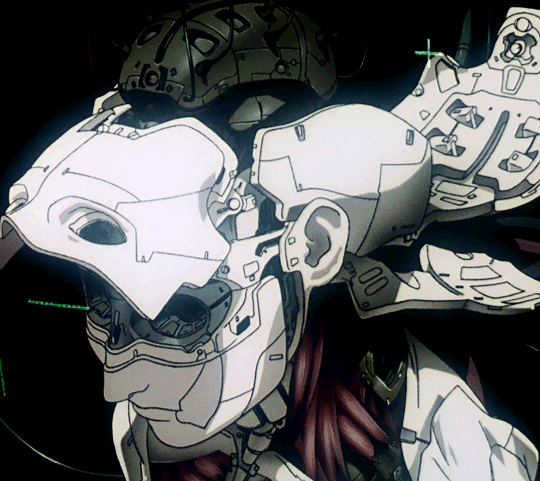
(Originally this was just going to be an excuse to talk about Ghost in the Shell... but I gotta be thorough.)
This was all brought on from this picture from a 1989 fanart magazine...
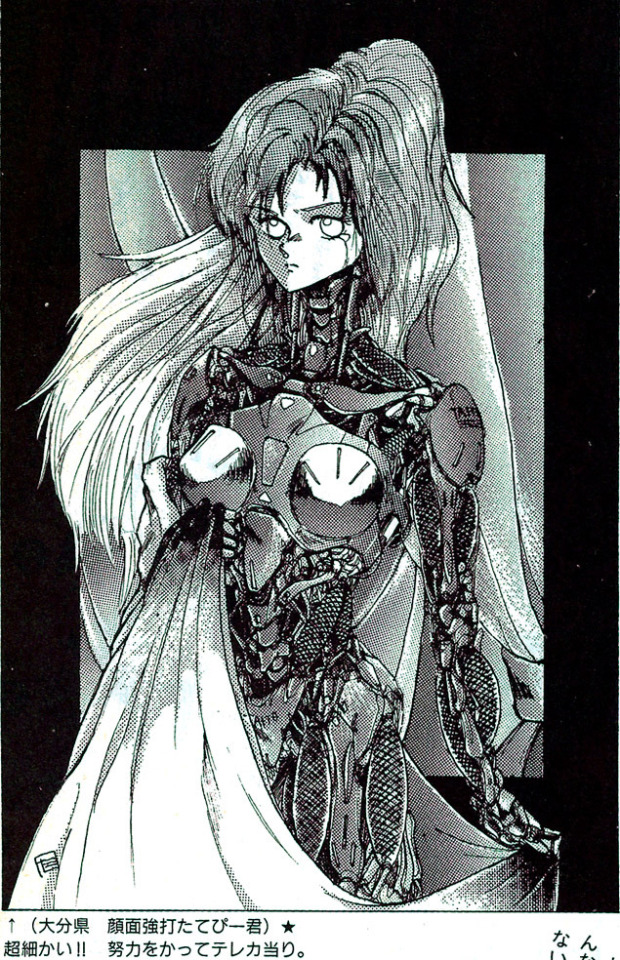
by an artist going by ‘Facepunch Tatebi-kun’ (顔面強打たてびー君, Ganmenkyouda Tatebii-kun). I remarked that it was interesting to see these kinds of ‘robot muscles’ in a picture from 1989, since I thought that kind of design became popular in the 2000s.
On some reflection, I think I gotta revise that opinion! I think ‘robot muscles’ became a thing around the mid 90s in anime; in the West I think it took a bit longer. But you can also see precursors already before that.
So. One thing artists are super into is biomimetic robots. That is, robots whose form (and perhaps function) is similar to animals, especially humans. The word ‘android’ referring to a human-like automaton dates all the way back to the late 19th century, but the modern ‘android, robot, cyborg’ taxonomy apparently became established around the 40s.
There’s two types of humanoid robot that get a lot of play, especially in anime. One is the convincingly humanlike cyborg, which is the same size and shape as a normal human; the other is a what we call in English a ‘mech’, i.e. a big robot you can sit inside.
Of course, if your androids just act like humans all the time, then there’s not much point having them be robots. To really create the frisson of contrast between human and mechanical forms you have to show the mechanism somehow. This could be because the machine isn’t perfectly human-like, and has visibly mechanical joints - take a look at the works of @sukabu89 for very inventive depiction of this theme - or, the android could be damaged or undergo maintenance.
When you attempt to translate biological forms into a more mechanical design language, the traditional way has been to use hard, rigid shapes, since these make the contrast especially clear. In more recent designs, particularly as we started to see real robots with ‘artificial muscles’ such as the ones created by Boston Dynamics, we get another sort of design language to express ‘mechanical parts’, and robots start having more biological forms with exposed plasticy muscles.
So let’s tell the story. We begin at the end of the 70s.
the dawn of mechaguro
For an early example of ‘mechaguro’ (a term I’m applying very anachronistically!), when a robot gets smashed up, we have Alien (1979). This film did a ridiculous amount to define sci-fi design language, and of course the alien itself blends mechanical and biological forms, with its glossy black surface allowing it to seem to melt into the exposed pipes of the spaceship. But let’s focus on the character Ash, a secret android who is broken apart in the second half of the film.

When Ash is torn apart by the alien, his insides consist of weird white plastic beads and a milky fluid that seems analogous to blood. It’s not clear what the function of any of this tech is - it’s intended to be vague and mysterious. The outside is biomimetic but the inside is anything but. He has a kind of artificial skin which resembles a latex mask.
The Terminator films are another major touchpoint for 80s science fiction. Late in the film, Arnie starts taking damage which reveals the Terminator skeleton underneath his fake skin.


The stop-motion Terminator model is basically designed according to the principle of ‘replace human bones and muscles with hard metal bits’. So you have a metal skull, metal clavicles (which are pistons for some reason), metal shoulder blades, hydraulic pistons generally in the places where muscles are. e.g. in the above picture you can see pistons that stand in place of the sternocleidomastoid muscle, and in this picture...

...you can see metal scapulae and piston biceps and triceps and a piston. The shoulder joint by contrast built in a very non-human-like way. Also there’s random tubes everywhere lol.
That’s generally how androids are portrayed in the 80s. The ‘droids’ in Star Wars are similar; C-3PO is an arrangement of metal plates with gaps suggestive of underlying mechanical details and rudimentary joints and pistons.
In Blade Runner, we have the Replicants, humanoid robots - but by the premise of the film, they are essentially indistinguishable from humans. So when the Replicants die, we never really get to see their robo-innards.
and now, anime
OK, that’s the big four Western 80s sci-fi movie series; what of anime? Of course, androids in anime go all the way back to Astro Boy. But most of these early designs don’t really focus on mechanical details all that much. Super robot designs are more like tokusatsu suits than anything. There were certainly instances of impressive mechanical animation in the 70s, with early experts including Kazuhide Tomonaga on Space Battleship Yamato. Then there’s Hayao Miyazaki’s episodes of Lupin III Part 2 which featured proto-Nausicaa flying a prototype of the robots from Castle in the Sky. It would be some years before anyone could come close to matching these!
The original Gundam in ‘79 famously started the ‘real robot’ movement [Animation Night, so let’s take a brief look at how a Gundam fits together.
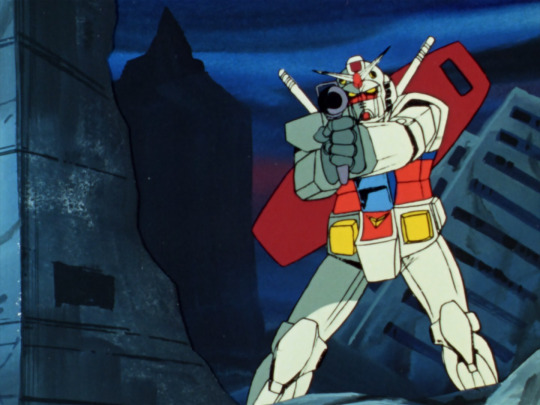
Generally speaking, the way Gundams are drawn in Gundam ‘79 is kind of rough. The methods to animate these rigid mechanical systems in super accurate perspective were just not yet established at the end of the 70s, certainly not on a TV budget. The actual joints on the Gundam are left very vague, but it broadly speaking seems to move like a human in armour.
But the OVA boom was about to begin, and while it would be a while before we saw the heights of Headgear/Production I.G./Gainax, things were going to change a lot. Mechanical design and animation was about to get much more sophisticated very very quickly.
In 1982, we have Super Dimension Fortress Macross, with robots that transformed into fighter jets. Its robots are designed by Kazutaka Miyatake, who cut his teeth doing mechanical design for Space Battleship Yamato and Daicon. The Macross TV series introduced the world to the animation of Ichirō ‘Missile Circus’ Itano. [AN64] A plane with legs... honestly looks kind of goofy, but Itano’s ambition to have a highly mobile 3D camera that could move in ways that would simply be impossible in live action marked a huge step up in how robots are animated. And this would get refined even further in the film Do You Remember Love.
In terms of design, we’re really moving our inspiration from ‘tokusatsu suit’ to ‘military hardware’ here. A Macross suit has to look like something that could transform into a plane, so its silly little arms and legs have to look kind of plane-like. In any case, we are definitely still in a world of hard and rigid robotics.
Dallos (1983-4) dir. Mamoru Oshii is known as the first OVA, if not the first successful OVA [AN115]. It features a variety of mining robots on the surface of the Moon, which are generally less humanoid, taking their design cues from JCBs...

...as well as humanoid robots with fairly clear joint patterns...

...and more humanoid robots too.
The eponymous Dallos, however, is a huge humanoid robot that looks like this...

Here we have a pile of mechanical shapes that vaguely calls to mind a human face. It’s suggestive of motifs we’d see later in works like Akira.
A year later in 1985, Megazone 23 really kicks off the OVA boom in earnest [AN 103]. It also has a robot, in the form of a transforming bike that can become a humanoid piloted mech...
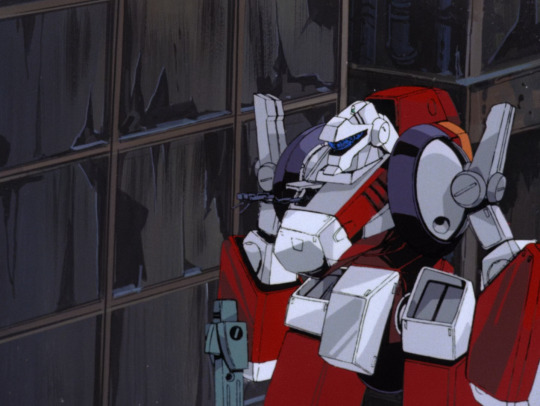
You can see mechanical designs and shading have become considerably more detailed; its motion is a lot more complex as well with a ton of indulgent background animation shots. The actual details of the bike -> robot transformation are rather brushed over. But to sort of sum up the design language: we have organic but hard-edged shapes contrasted by inorganic but round shapes. (These terms ‘organic’ and ‘inorganic’ refer mostly to symmetry and a sense of ‘flow’ in the shape.) There are few right angles as such, but a lot of broadly boxy topology. The shapes are broken up by elaborate specular highlights in complex shapes, a motif of the later Kanada school.
OK, but that’s all variants on ‘rigid robot’ so far - what about the androids? What about the more directly biological designs?
Following the enormous success of Megazone 23 Part I, Toshiki Hirano got the chance to adapt his favourite lesbian cosmic horror hentai manga Fight! Iczer One into a rather more tame OVA which released from 1985-87. In terms of mechanical design, this starts to do some interesting moves towards blending biological and mechanical forms...
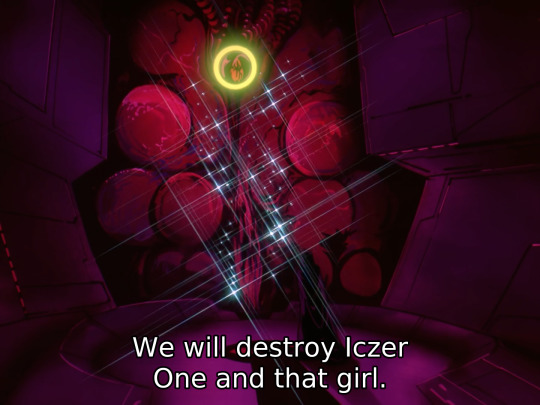
Of course it has a robot in addition to the requisite bishōjo and lightsabers. In contrast to the boxy shapes we’ve seen so far, the robots in Iczer-One have a much more curvy organic sort of design language. Still, there is not a lot of emphasis on the precise details of mechanical articulation outside of select shots. (It is however notable for the first ever Obari punch!)
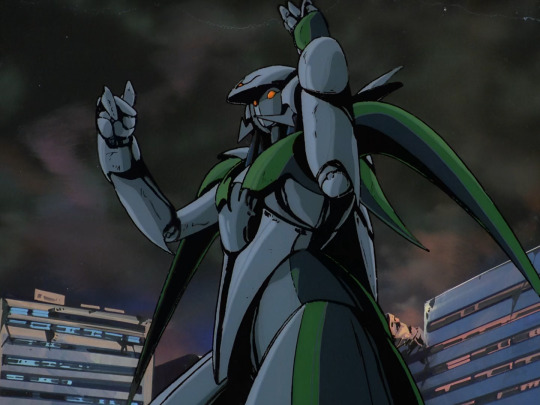
Despite the change in shape language, these are still very clearly animated as metal plates and not yet muscles.
In 1984 we have a very important film (for this narrative, and in general), Nausicaa of the Valley of the Wind, the film that created Studio Ghibli. Here we have the ‘God Warriors’, giant humanoid weapons with the ability to shoot a massive laser out of their mouth. Rather than robots, these are very much biological in nature, having to be grown in a kind of cocoon. In the film version of Nausicaa, an incomplete God Warrior is released, leading to an iconic scene animated by Hideaki Anno in which the God Warrior attempts to blow up the oncoming wave of Ohmu.

The God Warrior’s melting flesh is gorgeously animated, bubbling and sloughing off in great big lumps as the skeleton pokes out from underneath. Throughout, Nausicaa is full of beautiful and impressive animation of both machines (mainly planes) and biological (the giant insects), but the God Warriors, as human-made lifeforms, bring the two together. However, this strand wouldn’t be especially followed up on for a long long time.
Right, but what about Bubblebum Crisis (1987-91)? That is, after all, the iconic 80s robot girl OVA. It’s inspired heavily by Western robot-related films like Terminator and Blade Runner; here we have ‘Boomers’ (never stops being funny) as androids that can appear convincingly human. Like the Terminator, the underlying metal parts can burst out. Here we have a metal frame designed to resemble muscles, and also metal tentacles.
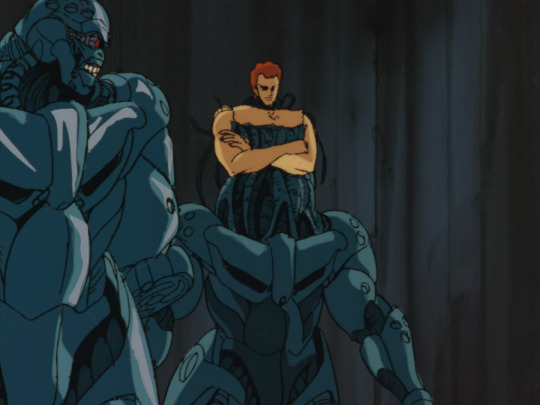
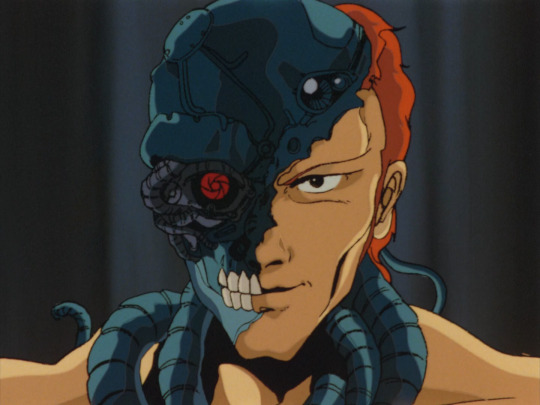
The shapes of these robots are a lot more organic. The robot neck has tubes that sort of resemble the neck muscles, metal plates that resemble pectorals and abs and deltoids and biceps and so on. You’ve even got a direct riff on the Terminator ‘fleshy face falling away to reveal metal skull with glowing red eye’! Under the plates there are clusters of tubes which also heavily resemble muscles. Also you’ve got the classic ‘three small circles’ motif there.
Contrasted against them are the Knight Sabers, who aren’t cyborgs as such but fight in powered exoskeletons which fit the design motifs of robot girls.
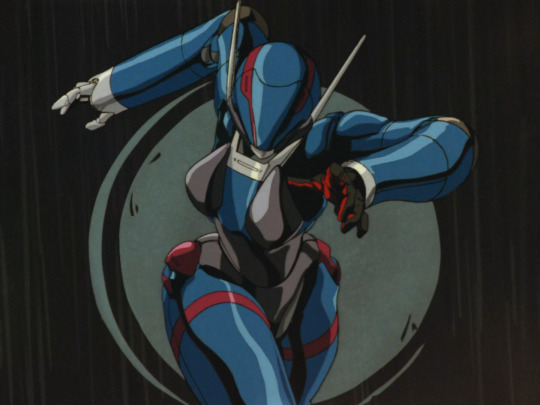
These suits are quite form-fitting, with a rubber under-layer and metal shells on top. There is definitely some attention paid to how they’ll articulate around the joints. One very recognisable 80s motif is the sort of extending spike thingies you can see on her hat there; there’s also the jets that extend out behind the suit. And, you have that multi-layer shiny highlighting of course!
Still, the way the characters move in Bubblegum Crisis is still very squarely Kanada School poses; big movements, lots of held poses accentuated by flashing and line boil, not a lot of concern for conservation of momentum or anything like that.
For a contrasting strand we can look at the rise of the ‘Otomo school’ (if you will) of realism. Around the end of the 80s, a pool of talented animators were gathering around Katsuhiro Otomo. Their most famous work is Akira, but I’m actually going to begin with Robot Carnival (1987), a wonderful anthology of short films from 1987. This features a huge variety of interpretations of the concept of robots.
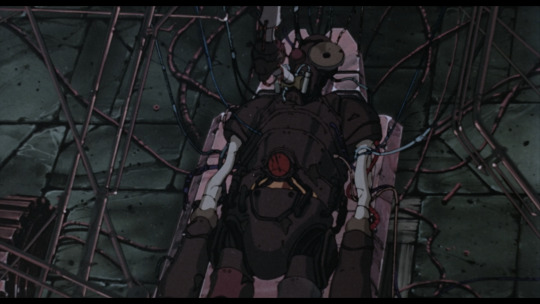
For example, for Kōji Morimoto, later co-founder of Studio 4°C, the robot is a kind of cobbled-together steampunk Frankenstein’s monster. It’s a very cool design with all sorts of asymmetries and exposed parts suggesting its cobbled-together nature. And although all the robot does in this short is stand up and then fall over, a great deal of attention is paid to the little details of its articulation and its movement through space.
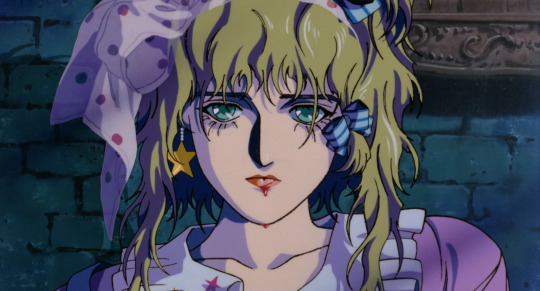
Presence, directed by Yasuomi Umetsu, is notable for its steps in the direction of realism - Umetsu’s characters are hyperdetailed and in some ways over-drawn. The opening shots establish this is a world where lifelike androids are common, when an android gets his head kicked off and stolen by children. Here the robot-as-doll metaphor comes in, something that will be increasingly central in the next decade. The robot girl is essentially a human-sized doll in a room full of other toys. Her creator smashes her to pieces with a wrench; later her ghost visits him as an old man. We see the girl attached to a bunch of wires, but she bleeds like a human.

Cloud by Manabu Ōhashi features another humanoid robot, an Astro Boy-like child recognisable as a robot based on his segmented torso and legs and robotic ear... cones. Here the robot is a standin for human emotions, the boy’s struggles projected onto the constantly changing sky as he walks against the wind.
Strange Tales of Meiji Machine Culture: Westerner’s Invasion by Hiroyuki Kitakubo (later to direct Golden Boy, Roujin Z and Blood: The Last Vampire) is a sendup of mecha shows in which two very goofy looking steampunk robots operated respectively by Japanese and Western crews duke it out, laying waste to the city around them. The Japanese robot is basically a big wooden samurai...
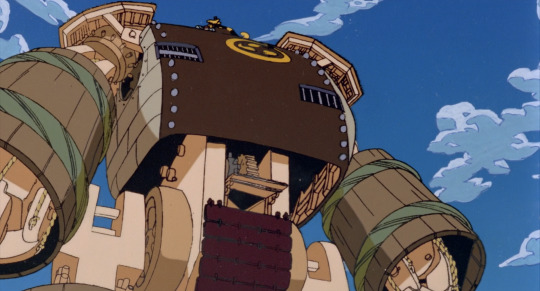
and the Western (more specifically American) robot is, uh
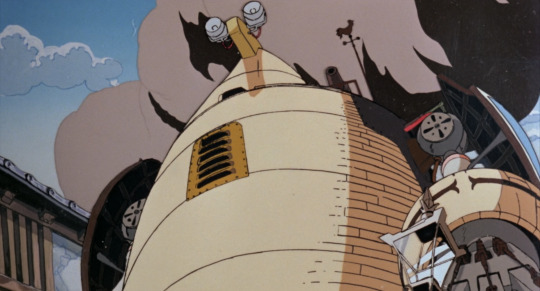
sorta big barrel with little eyes on top? I’m not entirely sure what the deal is with this design!
That’s really not relevant to our story tbh I just think it’s a neat short.
Chicken Man and Red Neck, by Takashi Nakamura, features especially distinctive robot designs. The film is kind of a dream sequence in which a terrified drunk man witnesses the revels of the machines of Tokyo, transformed into robots; the robots are extremely shaped, moving through a world that is pretty much just pistons...
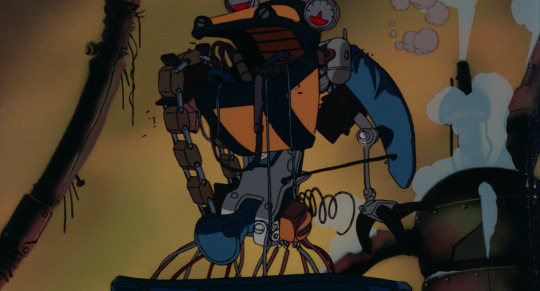
These robots call to mind the dancing demons in Fantasia’s Night On Bald Mountain sequence, or even Bosch.

Otomo’s own segments feature the Robot Carnival itself, a vast mechanical structure built as... well some kind of entertaining spectacle, but which now drives around the post-apocalyptic wasteland dropping robots which explode as bombs. It’s cute.
OK, to wrap up the 80s, we gotta cover Akira (1988) [AN34]! Akira has plenty of impressive mechanical animation of helicopters, hovercraft thingies, satellite lasers and of course the famous bike, but it doesn’t really feature robots as such - but what it does have is a blending of mechanical and biological forms in its climactic sequence where Tetsuo’s psychic powers go out of control. First, wires start to spread like the roots of a plant from his robot arm - less an actual machine and more something he assembled with his psychic powers...
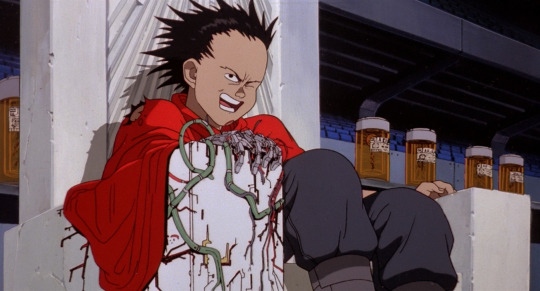
He takes a bullet, and the mechanical wires and muscles start to blend together and spread out like a slime mold...

...which he can extend as essentially a giant tentacle.
When his powers fully go off the rails, he bulges out into big blobs of flesh which have both veins and wires running over them. These burst out of the metallic parts as well.
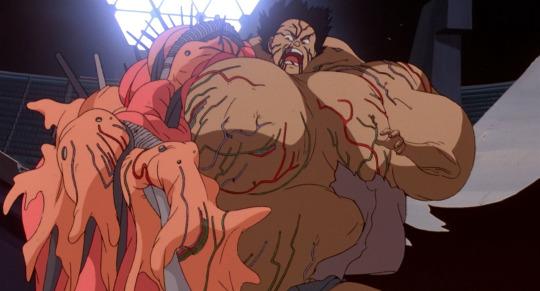
He turns into essentially a giant biomechanical baby.
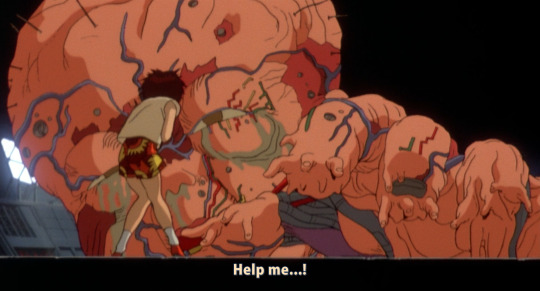
Did Akira invent these images of blending biology and machinery? Probably not, but I’m not really familiar enough with manga of the time to say. What can at least be said is that Otomo’s absurdly meticulous style could really sell it. Otomo was truly a god of perspective and detail; Akira the film was an enormous, prestigious production that threw ludicrous effort and resources towards realising his vision (which doesn’t mean it paid its inbetweeners much more...). A lot of the animators who worked on Akira would go on to be prominent in...
the 1990s
So, the 1990s. If the 80s was dominated by the later Kanada School, the new movement of the 90s, at least as far as film animation goes, was ‘realism’.
But before we get onto that, let’s take a brief look at Gunnm (1990). Known as Battle Angel Alita in the West, this manga by Yukito Kishiro depicts a world in which most people are cyborgs; it was adapted to an OVA by Madhouse in 1993 and became wildly popular overseas. Its protagonist Gally, aka Alita, starts out the story as a wrecked cyborg body like this...
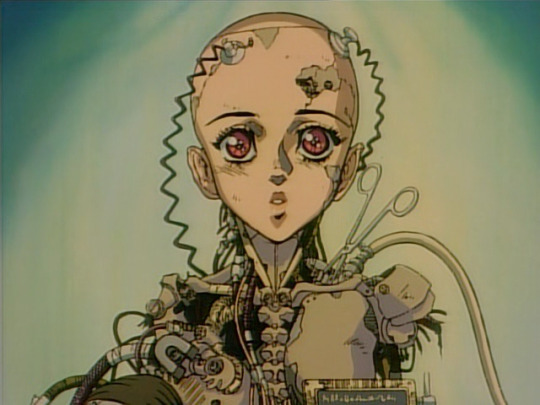
Looking at this design, you can see similar patterns as we have so far. We have metal clavicles, metal sternocleidomastoid muscle, metal pectorals, metal spine. There aren’t robot muscles, per se, but there’s a lot of attention to detail on mimicking biological shapes.
Before long she is rebuilt (twice in the manga, once in the anime). Her new body is like this...

...which is to say a skintight bodysuit in the middle, and metal arms. These arms, although designed in a way that indicates hard surface and with a hinge joint at the elbow, are designed in a way that mimics the flow of muscles in a human arm. By contrast, her sorta-love interest Yugo has a body like this:

which gets mashed to pieces in the finale of the OVA. There’s a striking mechaguro scene in which Gally catches Yugo, but leaves him hanging by a fraying arm, which snaps, leaving him to fall to his death. Compared to later iterations of the ‘robot arm torn apart’ device, this one’s relatively light on detail...
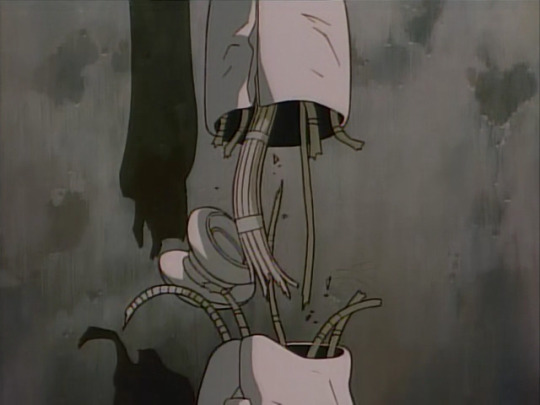
Cyborg bodies in Gunnm are used as a visual indication of character type. Gally has curves but also sleek robo muscles: she’s a Beautiful Fighting Girl, sweet but also extremely powerful. A huge ‘muscular’ cyborg with wide shoulders is likely to be a brute. Yugo here has much more plain, simple shapes with visible bolts, not precision pieces like Gally.
I don’t know how much of this originates with Gunnm. I’m sure the idea of cyborg girls was in the air long before, but this became an influential example on the tail end of the time of the 80s bishōjo. One device that is notable here is the idea of a ‘full body cyborg’, which is only human down to the brain (or perhaps not even that). Body swapping is a major theme in Gunnm, something that would be expanded on before long...
And if that was going out, what was coming in? Let’s look at Patlabor, which traces the evolution of the Headgear artistic collective and IG Tatsunoko into Production I.G.. This is about as down to earth as giant robot stories can get, with robots as just everyday machines used for work and by the cops. But where things really go nuts in animation terms is the opening to Patlabor 2 (1993).
youtube
Here you can see some of the most impressive sequences of mechanical animation ever drawn. We see pilot Noa testing out the robot, and especially notable are the scenes of the hand flexing and of walking. Enormous attention is paid to the articulation of joints. The robot’s hand can swivel 360 degrees, unlike a human; however, like a human, the articulation of the fingers seems to be controlled by hydraulics in the forearm (whereas in humans, the muscles and tendons in the forearm control our fingers). When the robot’s foot steps, it flexes like a real human foot, with believable joints, and a sensible arrangement of pistons to absorb force.
It’s not imitating a human’s muscles, but the attention to the details of the robot’s mechanical design serves precisely to draw our attention to the ways it’s like/unlike a human - the robot’s hand impossible motion immediately contrasted with its pilot shot from the same angle. And the perspective drawing is absolutely impeccable. The robot is made of purely rigid structures, and the way rigid structures articulate is not at all how a human’s joints articulate.
The sequence above was animated by Atsushi Takeuchi. But across the board, the bar was getting pushed for mechanical animation. For example, observe this cut from Mobile Suit Gundam: The 08th MS Team (1996-1999), in which the robot tears off its own arm and beats up another robot. The precision of the way the joints are animated and the way the robots move in space is just completely on another level compared to what Gundam had been doing a couple of decades prior.
Anyway, we’re here to talk about robot muscles, and we’re just a few years out from that now!
The year that robots got muscles, at least as far as anime is concerned, is 1995.
You can probably guess the next part. In 1995, we get Eva and GitS. Let’s start with GitS, to continue the Production I.G./Mamoru Oshii thread. The opening sequence of GitS, animated by - who else could it be? - Hiroyuki Okiura - has to be one of the most iconic segments of video ever drawn. Here’s a merely 720p youtube upload but go and find the place you have GitS stored on your hard drive and watch it in proper quality eh.
youtube
OK, yes, a lot of it is a naked lady floating around, sue me or whatever. But the sense of form. We see early on an appearance of ‘robot muscles’, here closely resembling real muscles...
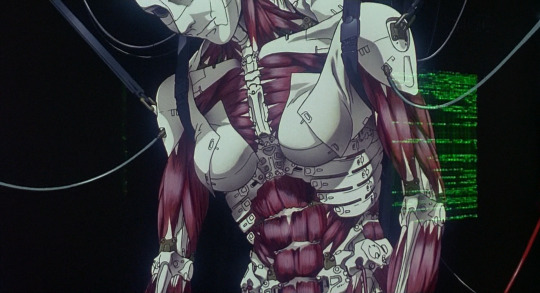
We can see from the way this is drawn that it’s made of a combination of artificial muscles, solid segments, and flexible, fabric-like panels. One of my favourite shots at the beginning shows the solid segments of the skull clicking into place. Here we have a very clear contrast between the angular, hard edges of the mechanical pieces against the organic forms of a human body.
Elsewhere in the film, we see various incredibly cool bits of ‘wouldn’t be fucked up if a body did this‘, like the fingers...
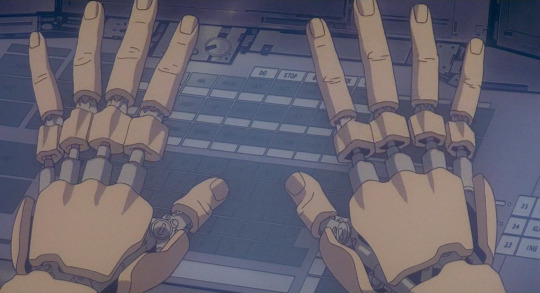
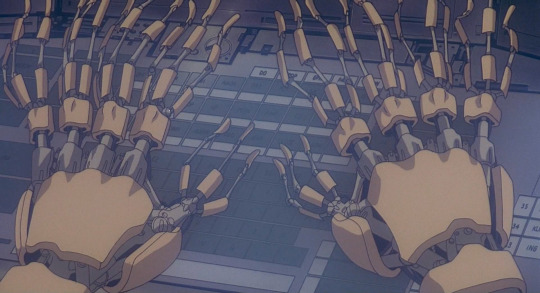
Here, what we expect to be soft biological fingers is contrasted with unexpected rigidity, mechanical joints under a shell.
Also in this scene we encounter a robot body that has been stripped of her arms, legs and hips but is nevertheless still alive...
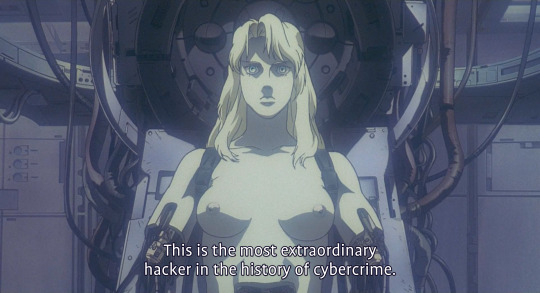

most extraordinary hacker in the history of cybercrime and you have your titties out and yet you still can’t get them to stop misgendering you, smh
For the Terminator, having its body smashed up and continuing to walk was a demonstration of its strength. Here, as would become perhaps an increasing motif, having a robot body is a source of vulnerability: people can do things to you that would kill an ordinary human but you keep going through it. Not surprisingly, ‘robot body maintenance’ is a recurring porn device. (One that GitS deploys in SAC s2).
But of course this all builds up to the all time classics of mechaguro scene at the ending where the Major attempts to tear off the hatch of a spider tank. Muscles ripple individually under the surface of her skin, her arms bulge in exaggerated contraction, and then her arms fully tear apart under the force.
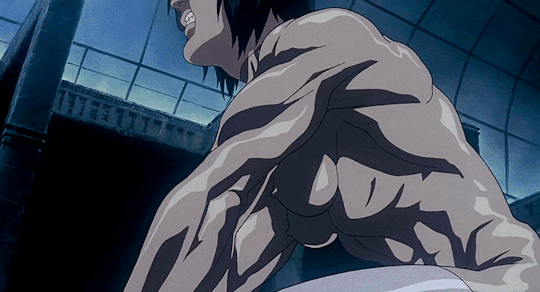
Here, we’re showing her as mechanical not by contrasting rigid forms with biological ones, but by exaggerating the biological ones to the point of doing something extremely unnatural. Human muscles do not generally flex in such an individual way, nor are they strong enough to tear the arm apart, but robot muscles? Yeah, they could do that. This sets up the next scene where the Major lies unnaturally still, but can still exert control through hacking through her union with the Puppet Master.
Robots holding onto something so hard their arms explode has become... if not a recurring image, then at least one that was called back decades later in Violet Evergarden.
The final scene of GitS brings back the image of robot-as-doll, with the Major’s consciousness now uploaded into a black-market robot body that resembles a child in a dress.

This is further expounded on in Oshii’s second GitS movie Innocence (2004), with its Ballade of the Puppets in the soundtrack as Batou and Togusa (and eventually, the Major) are attacked by essentially an army of ball-jointed doll gynoids. The puppets’ movements are extremely unnatural and erratic acrobatics, constantly flipping all over the place; when hit by bullets, panels pop open to reveal the underlying brass skeleton. It’s a very cool image. (The thing that lets the sequence down is the extremely dated CGI and aggressive digital compositing.)
It also has Donna Harraway as a literal cyborg!
Now, the GitS movies didn’t drop fully formed out of nowhere, but draw on the work of Masamune Shirow. The manga has a somewhat different design sensibility than the movie, distinctive and shiny as all Shirow’s art. It is more rounded and organic, less cold.
So, the basic design of a cyberbody originates with Shirow. You can see it on this page (unfortunately from a flipped version, translation Dark Horse):
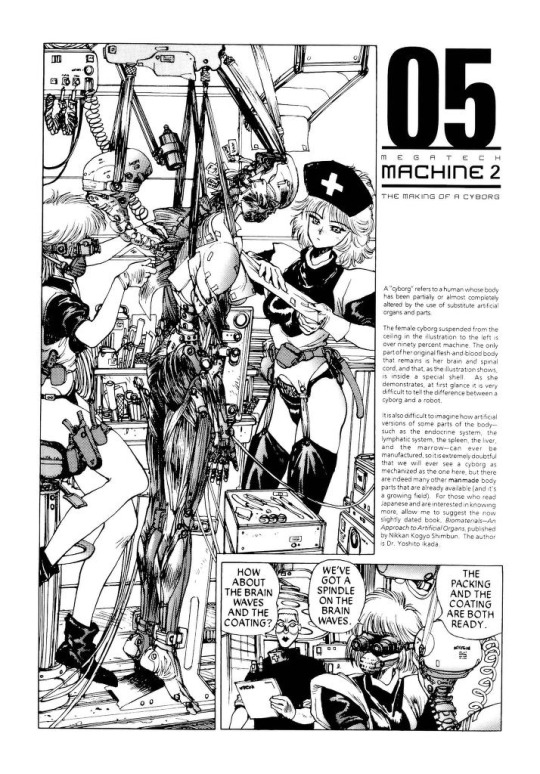
You might be able to determine from how the nurses are dressed that, yeah, the GitS manga is in significant part fetish porn. But really nerdy fetish porn, which is the best kind. This chapter is almost entirely dedicated to explaining how cyborg bodies are constructed in great detail, from the ‘sensory film’ (that’s what’s being applied in the opening to the 1995 film) to the hair implantation.
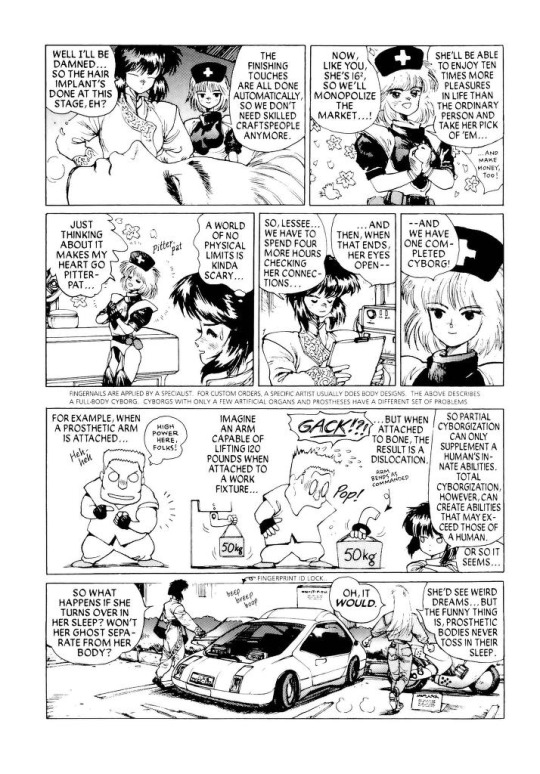
It’s interesting seeing how some of the more out-there designs of the manga, like Chief Aramaki, are transformed into the realist style of Hiroyuki Okiura. It’s Okiura, so it works great of course.
I don’t know if there are manga examples of such detail about cyborg bodies that predate Shirow.
Anyway, that’s just one of the two punches dropped in 1995. The other is Neon Genesis Evangelion. To the pedants: sure, the Evas are not actually robots, but they’re giant cyborgs that play the role of ‘robot’ in the story and they look like robots so I’m counting them.
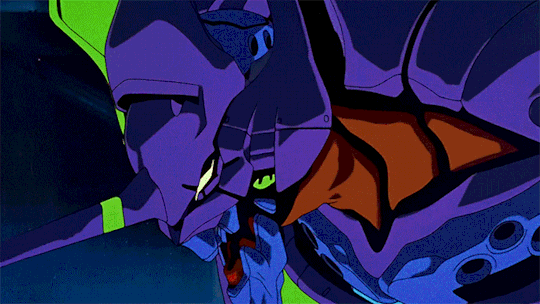
Anyway, the thing about the Evas is they are incredibly lithe. They run, rip and tear and swing heavy objects around in a way that’s both weighty and distinctly biological. Their bodies are extremely flexible compared to prior mechs (look at how much the spines bend in that Iso cut from EoE!), but not without hard, rigid components such as the shoulder towers. Their jaws are bestial but feature mechanical-like components like interlocking hexagonal teeth and jet-like vents. They are in short a fantastic design that blends biological and mechanical features.
The impact of Eva on just about everything can’t be overstated, but as far as robot design, well. There certainly were works that leaned on the precedent set by Eva, as for example RahXephon, which also treats robots as something spiritual, prone to popping into a blob of weird little bubbles just like in Eva.
There’s a great deal missing from this account. I am very focused on anime because I’ve watched a lot more anime than I’ve read manga or played games from this period. So I’m sure there’s major foundational works I’m missing here!
the 2000s
When did the West start to catch up? eh that’s subjective - David Cronenberg was way ahead of the game! - but specifically in the sense of robots with mechanical muscles, I think the major points in the timeline go a bit like this.
In 1999, there’s the Matrix, which leans heavily on anime. This features a similar ‘robot takeover’ premise to Terminator, but here it’s biomimetic robots modelled after squids, with clouds of constantly moving tentacles that sweep behind them. After making a cool half a billion dollars, the Wachowskis decided to pay all their favourite anime directors to make short films. I’m not going to comment on every part of the Animatrix, since most of it isn’t really relevant, but I will point to this horrifying cut by Takeshi Honda in The Second Renaissance in which a robot woman has her clothes torn and then skin bashed off by a mob. The framing, motion, her expression of abject terror, and the ‘reveal’ of her ‘true’ nature, all viscerally call to mind a trans bashing.
On the manga side, a big one to mention is Gantz, a gory nihilistic seinen manga which ran from 2000-2013. The characters in Gantz fight in special latex-like suits which take on the appearance of muscles while engaging superstrength, but can also sustain damage that causes them to drip fluids from ports located at the neck and become fatal to their wearer. Gantz was adapted to anime by Ichirō Itano in 2004, but I haven’t seen it so I can’t comment on any notable animation.
Cyborgs are a favourite subject of games, but in the 2000s, games are really pushing art direction and biopunk stuff is in. Half Life 2 (2004) has its spider-crab like Striders and dropships and so on. Oddworld: Abe’s Oddysee (1997) bases its whole concept around the sheer variety of weird creatures that would inhabit its dystopian factory. And I gotta give a shoutout to Septerra Core (1999) - in case one other person has played that lmao
At some point after 2005, Boston Dynamics became a viral sensation thanks to their robot BigDog. BigDog is just welded steel and hydraulics, but its lifelike hopping movement style definitely brought to mind the idea that the future of robots is going to be in biomimesis.
So, 2007, here comes Crysis to melt your PC! This is an FPS with the not-uncommon premise of being a supersoldier fighting (country America hates) and also aliens, but its gimmick was that you have a special exosuit that wraps around your body with artificial muscles, making you much stronger and manlier or whatever.
youtube
This is indicated by a visualisation that could be right out of a toothpaste ad, where tiny little balls drop into the character’s pores and somehow go straight into the bloodstream which is of course a void full of flying red blood cells. And so on. It sold the game, though! The ad there focuses almost entirely on the suit and not the character wearing it, who is basically an irrelevant soldier man. What it entailed in gameplay terms is that you have a mode switcher so you can have strength or armour or invisibility or whatever. But it’s cool military superscience, you see!
Anyway. Not like my preferred flavour of cyborg is any less stupid I guess x3
In the same year, Bayformers started. These films’ robots are honestly just visual noise, there’s so many moving metal shards going every which way that it’s next to impossible to discern any sort of underlying mechanical principle. A similar ‘overwhelming business’ visual effect would be applied the next year in Iron Man, kicking off the MCU. So mechanical muscles definitely weren’t the only expression of ‘hyper-advanced robot’ in Western visual media in the late 2000s.
I’m going to end my story with two more games: Horizon Zero Dawn and NieR Automata.
Horizon features a world inhabited by a large variety of robot animals, using the peak of AAA rendering techniques. The robots are designed to be biomimetic after both modern animals and prehistoric ones, and feature a combination of hard surfaces and softer biological muscles. For example, a robot horse:
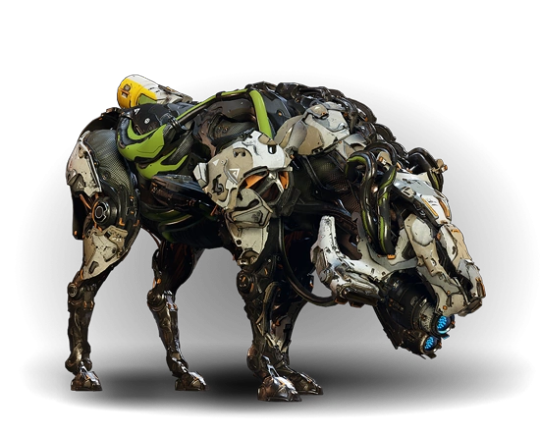
The discipline of making designs like these now has a name: it’s called ‘hard surface modelling’ and it involves boolean operations and bevels and other techniques designed to create a balance of hard edges on a surface against the smoother parts. The design language of Horizon says that the hard plates are white, the soft parts are very dark and may be patterned like a cloth texture, and there can be small colour accents here and there.
I think you can definitely see the influence of Boston Dynamics’s robots (and recent military tech in general) in these designs, iterated on through a decade and a half of increasingly intra-referential concept art. They are visually very busy designs, but there are a couple of recognisable features that draw attention by being inorganic, such as the cylindrical fuel tank at the back. Vitally, the silhouette is very readable.

This robot T. rex for comparison serves as a world boss monster, and you can see it’s got a bunch of military looking attachments that look like radars and missile launchers and so on. As real tech evolved, so too did our idea of what a scary robot ought to look like.
So, that’s where this kind of design pattern has gone in mainstream games.
Now to finish, a brief comment on NieR Automata. Its designs draw hard on those of Ghost in the Shell. Visually it draws a strong contrast between the Machine Lifeforms, who have inorganic shapes (spheres and cylinders) and very visible and plausible mechanical joints, and the doll-like androids, who might as well be human (although A2 provides some contrast in an android who is damaged enough for the underlying materials to show through). The mechanical nature of the androids is communicated by the acrobatic way they move and the interface elements, and dead androids you find in the field - and later when they start losing arms and stuff, it’s a whole thing. But just like humans in Yoko Taro Games, they’re capable of dying in a puddle of blood.
(I guess if you take one thing from this post it’s that if you’re a robot, don’t expect to keep your arms.)
Robot muscles gives you a chance to give both the ‘anatomy porn’ of drawing something very precisely right, with the added bonus of giving you a reason to draw the muscles ��corché, and the chance to make it weird and defamiliarised by splitting it with mechanical elements. In short... they look cool!
In this whole post I’ve basically not touched at all on illustration. I can point to a variety of illustrations of robot girls, but in terms of periodising them, I just don’t think I know enough. Though it’s safe to say that cyborg bodies in various states of construction or disrepair are now a mainstream of concept art - and that Ghost in the Shell is usually cited as an influence. I don’t know if robot muscles ever truly became the mainstream way to depict a robot, but it does feel like they’re increasingly common.
One artist I will briefly mention (besides sukabu), mostly bc I think they’re neat, is Haruyo Megurimu, who draws these very intricate designs of ‘necrotech’ which is sort of very biological robots extending out of human bodies - limbs extended on long spindly insectoid strands, jaws splitting open, that kinda thing. Can’t say who influenced them or anything but it’s a compelling extension of the idea into a particular corner of aesthetic space.
And that’s all I’ve got I think. There’s definitely big gaps like. More recent sci-movies. Western comics. Nevertheless, that’s an arc.
If you’ve read this far: thank you for indulging my autism.
787 notes
·
View notes
Text
cross disciplinary training in gubat banwa

so, GUBAT BANWA is a big martial arts game of esoteric martial arts. of beatdown and bone breaking. bakbakan at suntukan, pangamot ug pagdaug. it focuses on martial arts and the culture that surrounds that. during ancient seasian times (the main foundation for this game), formal categorized schools didn't exist: participating in your culture was you learning its martial arts, or a random hermit in the sea cave could teach you a secret martial art, or your family could have its own secret martial art, etc. etc.

so martial arts classes (in gubat banwa they're called Disciplines) are expressions of culture and tradition. from a mechanical side, I knew I wanted to make Gubat Banwa a multiclassing-first game, a la Lancer, for multiple reasons
I like multiclassing, I almost always multiclass
You get access to more of the game and the game's lore (much of Gubat Banwa's lore is in the disciplines)
You get to write a plurality of classes that deal with a plurality of playstyles
It makes writing Disciplines easier--they become small packages of power instead of the long Narrative Playbooks that they are a la D&D 4e's classes. this also makes making Disciplines easier as you don't have to write one for a 12 Level long progression
it creates a more emergent character progression (a Mangangayaw learning Sword Saint techniques for example might be a raider who raided a Virbanwenyo settlement and got the resident martial artist to teach him a thing or two, or it could be that they started picking up how Virbanwenyo Penitents fought)
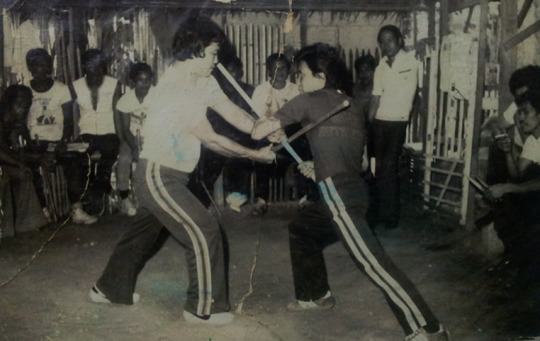
however, Disciplines were more than just classes, they're also martial arts in their own right. So as I deepened my understanding with the Martial Arts I also found further justifications for multiclassing [which we like to call crosstraining]). these are from my and GB's Art Director Dylan's experiences from Filipino Martial Arts:
to become a true grandmaster is to learn or observe a large variety of styles (see: Johnny Chiuten, Anciong Bacon, etc.)
most real grandmasters that began their own FMA schools are those that studied and learned techniques from a wide variety of martial arts (Anciong Bacon knew Boxing and Dumog, for example. Johnny Chiuten knew multiple Chinese Martial Arts and trained in Balintawak and Lapunti, GM Filemon Caburnay learned both the arts of blacksmithing and of multiple arnis styles as he traveled across Visayas and Mindanao, and learned Kung Fu from Johnny Chiuten, before going down the path of perfecting his own fighting style that became Lapunti Arnis de Abanico)
even my own master in Lapunti who started with Lapunti was exposed to other Arnis and Martial Art styles so he was able to build his own style around it, and was able to contribute his own moves into modern Lapunti. i can see a bit of Chinese Martial Art influence in his movements now, a bunch of balintawak progression
very often if you're a student of violence, you will be learning multiple combat arts both out of necessity and out of love for movement. a balintawak warrior might have their movements augmented with jiujitsu training, a lapunti could benefit from learning sikaran, etc. etc.
kadungganan are meant to be nascent grandmasters, especially those that reach legend 12, so this is the main justification for the multiclassing instead of just having 1 martial art that you perfect. in real life this doesn't really happen, especially if you want to perfect your own fighting style. the assemblage of multiple techniques from 12 Legends worth of progression is there to facilitate the fantasy of a Kadungganan perfecting their martial art style, like the grandmasters of old

i knew since the earliest stages of gubat banwa that i wasn't going to compromise the multiclassing aspect, i just find it very serendipitous that crosstraining fits so well into the martial arts fantasy. it makes me pretty satisfied and happy, and i'm glad i didn't bend to internal talking and thinking about making a "pure discipline" progression possible
125 notes
·
View notes
Text
Animal Room (1995)
Directed by Craig Singer, starring Matthew Lillard and Neil Patrick Harris, this movie is WILD. If you like Matthew Lillard, or you just enjoy strange and obscure movies, it's possible you've heard of this one! Well, I decided to write an essay on it, because I have autism I love this movie for some odd reason. Also, it is impossible to google information about this movie so consider this my version of Wikipedia for the movie, Animal Room.
WARNING: This movie, and the following post, contains a lot of dark themes. Please be aware that this movie includes murder, suicide, peer abuse, substance abuse, domestic abuse, animal abuse, rape, religious themes, satanic themes, gun violence, and very graphic depictions of pretty much all of the above.
Still interested? Alright, let's get into it then. (Also, this is really long, sorry.)
This movie is strange, confusing, terrifying, shocking, and downright disturbing. It supposedly takes place in the near future, though the exact year isn’t defined, and this can be seen through odd clothing styles and the occasionally weird setting choices. I would say a lot of it is inspired by the suburban gothic dystopian genre? (Niche, I know, but stay with me here.) Topped off with a hint of The Matrix… are you still here? Okay, cool, because it’s only going to get weirder.
First off, we need to know all of the characters, and there are a lot. Many characters have their names mentioned in passing, and as a result we don’t really know who is who, so I will do my best to explain them all.
The first person we see is known as Pink, played by Ryan Payne Bell. He’s a pale redhead with frizzy hair, typically seen wearing a bowler hat and trench coat. Pink is a part of Doug Van Housen’s gang, who we soon find hanging out on the pier of a seemingly abandoned carnival. Doug, often referred to as simply ‘Van Housen’, is played by Matthew Lillard. He has jet-black hair, styled in a messy bowl cut, and he wears multiple different outfits throughout the movie, always consisting of whites and blacks. His style could only be described as “modern vampiric”. (Which actually makes a lot of sense, once you get to know him.) His girlfriend, Shelly, played by Lori Heuring, has long blond hair and can usually be found hanging off of Doug’s arm. The other members of the gang include Eddie, Porky, and Hinge. Eddie LeMaster, played by Brian Vincent, has short brown hair and is usually wearing a leather jacket or a sleeveless shirt. Porky, played by Eddie Malavarca, can easily be recognized by his bright red (sometimes black) bandana and curly black hair. And finally, Hinge, played by Dechen Thurman, has straight brown hair that comes down to his shoulders and is always carrying, if not actively reading, a book.
As far as I can tell, the hierarchy of the gang is as follows: Doug is the leader, Shelly is his “consort” of sorts (she isn’t really treated as part of the gang, but more like an ally who gets special treatment), Hinge is Doug’s confidant while Eddie is the main instigator, and Porky and Pink are the goons who hang around just to be a part of the fun and do what they’re told. Hinge and Eddie seem to be important to Doug – Eddie is loud and excitable, likes to start shit and cause chaos, while Hinge is quiet and reserved and silently encourages Doug’s bad behavior. We see throughout the movie that Doug is often annoyed by Eddie’s behavior (along with Pink’s and Porky’s), whereas with Hinge he seems to enjoy his company. We see him often leaning on Hinge’s shoulder, listening to him explain complex topics or just zoning out while Hinge is reading a book. Their relationship is subtle, as Doug treats Hinge as if they were friends, meanwhile with the other three he’s a bit more leader-ly.
Eventually we meet our protagonist, Arnold Mosk, played by Neil Patrick Harris. Arnie is a young boy, with short blond hair and thin glasses, who is actively dealing with a drug problem. In his free time, Arnie sneaks into the school auditorium and takes hallucinogens while sitting out in front of the stage. He has no friends (minus Gary), no social life, and he talks like an absolute nerd with a cynical, nihilistic, and severely depressive outlook on life. Here’s an actual quote from him when someone asked him “What happened?”: “Oh, nothing untypical. Barbarians rarely capitulate.” … I mean, come on. Is it any wonder he gets bullied?
Anyways, we learn that the school has designed a special “class” of sorts for troublesome students, and Arnie (being a drug addict) has to be a part of that class. As a result, he’s become a target for Van Housen and his gang – well at least, he’s become a bigger target than before. There are two adults in the school who are important to the story, the principal and a teacher who acts as Arnie’s therapist. Principal Jones, played by Stephen Pearlman, is the secondary antagonist of the story, as his choice to continue the use of the "Class for Troublesome Kids" is the main issue for our protagonist, and Doug Van Housen’s abuse is simply a result of it. Meanwhile, Doctor Rankin, played by Joesph Siflavo, is Arnie’s only advocate on the schoolboard as he actively argues against the use of the "Class for Troublesome Kids" or, at the very least, that Arnie doesn’t belong in there. Throughout the movie, Arnie visits Rankin’s office to confide in him about his troubles, and in turn Rankin tries to convince him to stop using drugs.
This special class, known by the students as the ‘Animal Room’, seems to be either an all-day class or at least a homeroom for the students that are assigned to it. Principal Jones claims that the class is for the sake of the 95% of students who are not troublesome, and that the 5% who are should simply be kept away from the rest so that the majority can succeed. However, this means that the 5% of students who are not a part of the “good” population are rounded up together and left to fight amongst themselves. This classroom is found in a basement area, at the end of a long hallway filled with short flights of stairs and graffiti, and security guards sit (or, most often, sleep) outside the door. In this classroom, we find Doug Van Housen and the rest of his gang (minus Shelly) and some other students who have been deemed troublesome, such as ‘Baldy’ (more on him later) and Arnie. This room is filled with shoddy desks and chairs, cement walls lined with pipes and ductwork, and a single television which is always playing the same thing: a recording of a man dressed in all black, similar to the security guards, with slicked back hair and wearing matrix-style sunglasses. This man is usually inaudible, but is always speaking in a very authoritative tone and staring directly at the camera. Watching this TV seems to be the only thing in the classroom the students are “permitted” to do, although there is rarely a teacher, or even a security guard, inside the room to stop them from doing otherwise. If things start to get loud, however, the guards outside will come in to stop it.
Next, we meet Gary Trancer, played by Gabriel Olds. He’s Arnie’s only friend, and apparently has been his friend since they were kids, but in the past few years they’ve grown apart. Gary’s girlfriend, Debbie, played by Amanda Peet, apparently either temporarily dated or had a one-night stand with Eddie LeMaster, and as a result Eddie holds a grudge against Gary for “stealing his girl”. This, combined with Gary’s brave attempts to protect Arnie from the school bullies, makes him into a target as well.
Now that we know all the characters and their roles, let’s get into the actual story. First off, we truly learn just how bad things are at this school when Van Housen’s gang ambushes Arnie in the bathroom, and I’m begging you to skip the rest of this paragraph if you’d rather not be horrified by something that is so terrifyingly real it truly sickens me. Ready? Doug begins to beat Arnie, while Pink and Eddie are taunting him and Hinge is flicking the light switch on and off like it’s some kind of nightmare. We see Porky walk out of a bathroom stall, buckling his pants, and the boys grab Arnie and drag him into the stall, while he’s struggling and crying. Doug, who’s standing over the toilet facing Arnie, grabs him by the back of the head and shoves him face-first into the bowl filled with Porky’s shit. Arnie is gagging, suffocating, and essentially being drowned, until finally he stops struggling and allows himself to go still. The gang leaves him there, gasping, coughing, and puking on the floor of the bathroom. This scene may not be as bad in writing, but actually watching it play out legitimately made me feel sick.
Soon after, we see Arnie and Doug sitting in the principal’s office – Arnie, looking half-dead, and Doug playfully giving himself paperclip nails. The principal sits down and begins to scold both of them, as if Arnie had been equally in the wrong, and then proceeds to deal out zero punishment.
We then see Doug making his way home. He walks through a cemetery, passes by a lone guitar player sitting on a small dock playing Beethoven’s Moonlight Sonata (No. 14 in C-sharp Minor). His home is a giant mansion, and when he walks in he immediately strips naked in front of his butler, then walks up the stairs, leaving the butler to pick up his clothes. Meanwhile, Arnold is having a hallucination about being at a bar with creepy old men, presumably the one where he got his drugs, and is being strip-teased by a woman in white lingerie while a baby cries in the distance.
I warned you that this movie was wild, and it's only going to get wilder from here!
The next thing that happens is that Van Housen’s gang, along with Shelly, bursts into the home of Shelly’s family (Shelly being Doug’s girlfriend, in case you forgot). Her mother is upstairs taking a bath, while her father and brother are sitting at the table eating dinner. Once again, if you'd rather not be traumatized by the horrifying actions of Doug Van Housen then I suggest you skip the rest of this paragraph. They start taunting and torturing her father, who is confined to a wheelchair and begins to have trouble breathing. Eddie grabs a trash bag and pulls it over her father’s head, suffocating him for a moment before dragging him out of his chair, meanwhile Doug has climbed the stairs to interrogate Shelly’s mother, who is now wearing a bathrobe. Doug asks for the gun owned by Shelly’s father, threatening to rape the mother among other things. She slaps him, then gets the gun and asks him to leave. As the gang heads out the door, Eddie hangs back and pulls Doug aside, whispering something. The camera cuts to Shelly’s mother, sitting on the stairs, and Eddie walks up, grabs her by the hair and drags her to the bedroom as she screams.
I warned you, this movie is disturbing.
Later, in Dr. Rankin’s office, Arnie tells him a story about how a group of thugs once beat up Van Housen, and how slowly, over the next year, each of those thugs disappeared and were eventually found dead.
Later that day, Gary visits Arnie’s home to discuss how they’ve grown apart. He wants to reconnect, and they talk about going on a trip to the Caribbean, something they had always dreamed of doing back when they were children. They decide to finally take that trip in the summer, as soon as their final year of high school is over and before Gary has to leave for college. It’s important to note that Gary is the only person in the school, besides Dr. Rankin, who treats Arnie like a regular human being. Everyone else, even casual peers, see him as a freak or weirdo. Also, once Gary leaves, Arnie scolds his mother for being a drunk, and for acting weird when Gary came to visit. (To be fair, she was acting very weird, but it was obviously out of innocence, and I don’t think she deserved to be scolded like that by her own son.)
When we get to see Doug Van Housen’s room, we learn a bit more about who he is as a person, and Why He's Like That. Religious paraphernalia, paintings and statues line the walls alongside gothic hanging lamps and candles. His bed has a gigantic headboard, and we see him lying in bed wearing reading glasses, looking through a book that mentions King Henry VI.
We now get to meet Baldy, played by Huckleberry Fox, in the Animal Room. He’s drawing at his desk, while Van Housen’s gang is discussing hypotheticals, and Doug walks over and begins messing with him. Doug starts nosing the side of Baldy’s face, whispering in his ear tauntingly, then spits on the back of his head, where we see he has a tattoo of a ghoul. Baldy jumps up, turning around to yell “Why are you such a filthy scumbag?!” The gang all jump to defend him before a guard walks in to break it up.
Arnie has a hallucination about the carnival, where he finds the rotting corpse of Doug Van Housen wrapped up in plastic like a game prize. Doug asks him, “Do you see what your friend did to me?”
We cut to Baldy, who is helping to run a recording session for the band, Misfits (yes, the real band), and Van Housen’s gang is sneaking into the studio. When he isn’t looking, they sneak into the room and grab him. The band, on the other side of the glass (which is apparently one sided, as they can’t seem to see the events on the other side) begins playing again while the gang begins to interrogate Baldy for calling Doug a “filthy scumbag”. After a few minutes of torment, they shove Baldy to the ground and Doug begins slamming his head into the floor. The others look afraid, Eddie yells at him to stop, Baldy is bleeding and has gone limp. Doug wipes a hand over Baldy’s face, kisses his forehead and says “Goodnight.”
We then cut to Baldy’s father, sitting at home and staring at a picture of him, then we cut back to the gang who has now moved to their usual hangout on the carnival pier.
Shelly arrives (she must have gone home for a bit, since she had been there when Doug killed Baldy), and she’s holding a small rabbit. Porky and Pink are cooing over it, and Shelly brings the rabbit over to Doug for him to hold. She watches as he twists the bunny’s neck, killing it, and she begins crying and screaming hysterically. Porky and Pink decide to escort her home, Hinge and Eddie leave soon after, and Doug is left alone.
Pink, who is now seen walking around town, is cornered by Baldy’s father who pulls out a gun and shoots him. He falls dead on the street.
At school, in the Animal Room, Eddie pulls the fire alarm. Everyone is evacuated out of the building, but Doug corners Arnie and keeps him from leaving. Doug begins telling him the story of Job from the bible. Oh, and also he tells Arnie, “I want your blood in my mouth.”
Later, in Dr. Rankin’s office when Arnie is recounting the event to him, Rankin admits to Arnie that he’s going to be leaving the school due to a job offer. Arnie leaves, and when we next see him he has a gun. He pretends he’s pointing it at Doug, then considers pointing it at himself. We see him sitting in the school hallway, leaning against the lockers and fiddling with the gun. He puts the gun in his mouth, and a teacher and janitor catch him before he pulls the trigger. He points the gun at the janitor, who pulls out his own gun and shoots him.
Arnie ends up in the hospital, in a coma. His mother and Gary are there with him.
Van Housen’s gang, which has now dwindled to only four members, is once again hanging out on the carnival pier. Gary approaches them, holding a gun and pointing it directly at Doug. Doug makes Hinge, Eddie and Porky leave, then stands with his arms out, daring Gary to shoot. Gary screams, shooting off five rounds, each one missing Van Housen. Doug walks to Gary, carefully taking the gun from his hands. He shoots the last round into the air, then leaves with his friends.
Debbie (Gary’s girlfriend) is throwing a party. Gary is there, but sitting alone in another room, away from the other guests. Through the doors come bursting Eddie and Porky, behind them is Hinge who has Doug hanging off of him. As Doug steps out from behind Hinge we see he’s sporting a brand new look. His hair is slicked back, and a dark red circular mark is branded onto his forehead. His face is pale, and he’s wearing all black. The gang leaves, and it’s just Gary and Doug, alone.
Doug says he’s going to hurt Arnie as soon as he’s out of the hospital, and Gary tackles him. They immediately begin throwing punches, until Doug gets his hands around Gary’s throat and begins choking him. Doug tosses him to the ground, then pulls out the gun he took from him. Doug sits down on the floor, setting the gun in front of him and Gary grabs it, putting it directly to Doug’s forehead who then pulls his hand down to point the gun into his mouth. Gary backs away, dropping the gun fearfully.
Doug says, “Gary. I will be there when your children wake up. I will be there when you get married. I will be there at your next birthday. I will be there when little Arnie gets out of the hospital. You hear what I’m saying to you, Gary? I will always be there.”
“I will always be there.”
On the wall is a decorative sword. Gary takes it down as Van Housen holds his arms out, once again inviting him to make a move. Gary slashes the sword across his chest, mimicking Doug’s corpse in Arnie’s hallucination. Doug falls limply to the ground.
The police are called.
Officers walk into the room.
Doug is still holding the sword.
They shoot him.
My Thoughts:
Okay, so first of all, Gary was too good for this world. He was the only likeable character in the entire movie, and I was devastated when he died, especially because it was so sudden and they really make you think he’s in the clear. Second, Doug Van Housen, and his group, are absolutely fascinating to me. Their dynamics are just so intriguing, especially the one between Doug and Hinge. Of course, there are so many oddities about this movie that it all feels like a fever dream. The clothing choices, the symbolism, the dialogue, it’s all so wild.
Honestly, I don’t know if I would recommend this movie. On one hand I think it is fascinating, and could be very interesting to some people, but on the other hand it is hard to understand and will likely just leave you questioning things. You’re telling me Doug Van Housen has killed at least five people and faced no charges for any of those murders, when clearly everyone knows he did it? And then when Pink is killed, no one mourns him, and his death is barely even recognized by the characters. Baldy’s father had two seconds of screentime: mourning his child, and shooting Pink. That event is never acknowledged after that. Then, Shelly was so in love with Doug that she forgot who he was, she forgot that he’s a psychopath. She thought she was special, but she wasn’t. He kills her rabbit and then she’s gone, and we don’t see her again. And what about her family? They tortured Shelly’s mother and father, and they just chose not to press charges?? And last but not least, Arnold, who ended up in a coma, is going to wake up one day and find out that his only friend is dead. He was already suicidal, his mother might as well pull the plug and let him go because as soon as he finds out about Gary he’ll probably try to off himself anyways.
Really, the only way to truly understand the movie is to watch it for yourself. As far as I know there is basically no way to buy it anywhere online, and no streaming services have it. Thankfully, someone on youtube has uploaded the whole thing for free. You can find it easily just by looking it up! If you want to know when certain things happen (so that you can skip them or skip to them) or if you have any questions regarding the movie, feel free to shoot me a message or leave a comment!
#animal room#animal room 1995#doug van housen#matthew lillard#neil patrick harris#obscure movies#movie review#sleepless rants
25 notes
·
View notes
Text
fic: happy accidents (steve/bucky)

Title: Happy Accidents
Author: controlofwhatido
Artist: @auntiesuze
Rating: Explicit
Archive Warning(s): No Archive Warnings Apply
Tags: Captain America Steve Rogers/Modern Bucky Barnes, Alpha/Beta/Omega Dynamics, Alpha Steve Rogers, Omega Bucky Barnes, Mpreg
Summary: Bucky sleeps with one superhero one time and now he’s pregnant. Fuck. Good going, James B. Barnes. One unmated omega father, coming right up. Top that off with his metal arm and he’s really going to be an outcast.
Notes: Written for the 2022/23 @stuckybangs! Art is embedded in Chapter 5.
FIC IS COMPLETE: READ ON AO3
(@stuckybingo O3: Writing format: Present Tense, N5: Kink: Heat/Rut, G5: Arnie Roth, | @allcapsbingo: I1: Captain America Steve Rogers, O1: Pining, B1: Courting, O2: Rebecca Barnes Proctor | @mcukinkbingo N5: Coming Untouched )
#stuckybang#stucky fic#allcapsbingo2023#stuckybingo#auntiesuze#control writes fic#yes it's monday i got impatient lol#here we go finally!
128 notes
·
View notes
Text
All the places that participated in the Trojan War on the side of the Greeks according to the Iliad
Below is a list of all the areas mentioned by Homer, in their original names. Bold text is used for areas that retain their name, places that still exist and are inhabited or are unearthed ancient settlements. However, please keep in mind that my English transliteration might be all over the place, as I transliterated them on my own straight from the ancient text.
Boeotia: Aulis, Skhinos, Eteonos, Skolos, Thespia (nowadays Thespies), Mykalissos, Graea (nowadays Tanagra, do I keep it? It’s also the origin of the name Graecia > Greece), Arma, Eilesio, Erythres (nowadays a part of Attica), Yli (built near the lake that is still called Yliki), Peteonas, Okalei, Medeon, Thisvi, Koronia, Aliartos, Plateae, Ypothives, Oghistos, Arni (later Chaeronia), Mideia, Nisa, Anthidona (nowadays the area belongs to Euboea), Orchomenos, Minio, Asplidona.

Orchomenos
Phocis: Kyparissos, Pythona, Krissa (now Khrisso), Daulis, Panopeas, Anemoria, Iampolis, area around Kifisos river, Lilaea.
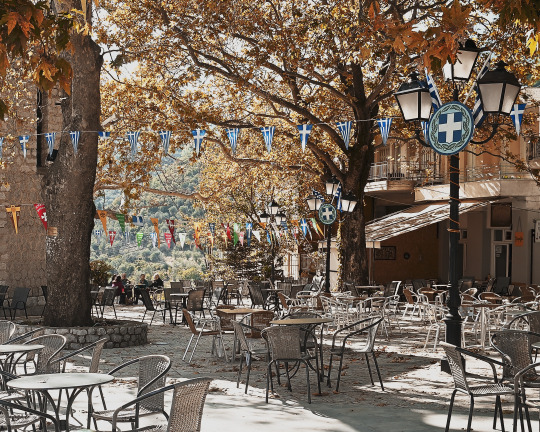
Daulis
Locris (present-day parts of Phocis and Aetolia-Acarnania): Kalliaros, Cynus, Opus, Avyies, Vissa, Skarfi, Tarfi, Thronio (the nearby settlement nowadays is Neo (new) Thronio, in Phthiotis).
Euboea island: Chalcis, Eretria, Istiaea, Kirinthos, Styra, Karystos (a 100% there, well done Euboea)

Chalcis
Athens
Salamina island
Argos (also called Argolis): Argos, Tiryntha, Hermione, Asini, Troezen, Heiones, Epidaurus, Aegina island, Masita, Mycenae.

Aegina island
Corinth, Kleones, Sikyona (nowadays Sikyonies), Tonoessa, Yperisia, Aegio, Pellini, Aegialos, Eliki.

Ruins of Ancient Kleones
Lacedaemona (also called Laconia): Sparta, Fari, Messi, Vrysies (could it be associated to the current village Vryses?), Avyies (could it be associated to the current town Aeyes?), Amykles, Elos, Loeo, Oitylon.
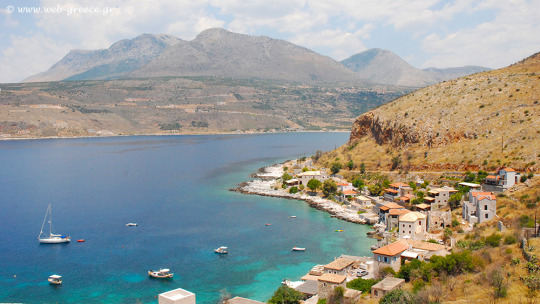
Oitylon
Pylos, Arini, Thryo, around Alfios river, Kyparissienta (nowadays Kyparissia), Amphiyenia, Pteleos, Elos, Dorion.

Kyparissia
Arcadia: Mount Kyllini, Feneos, Ripi, Stratia, Orchomenos, Enispi, Mantineia, Stymphalos, Parrasia.

Mount Kyllini
Ilida, Vouprasio, Yrmini, Myrsinos (nowadays Myrsini), Olenia, Alisio. Echinae islands (nowadays Echinades), Doulihion island.

Echinades islands
Cephalonia island, Ithaca island, Krokylia, Aeyilipa, Sami, Zakynthos island.

Beach in Sami, Cephalonia island.
Aetolia: Pleuron, Olenos, Pyllini, Chalcis, Calydona.
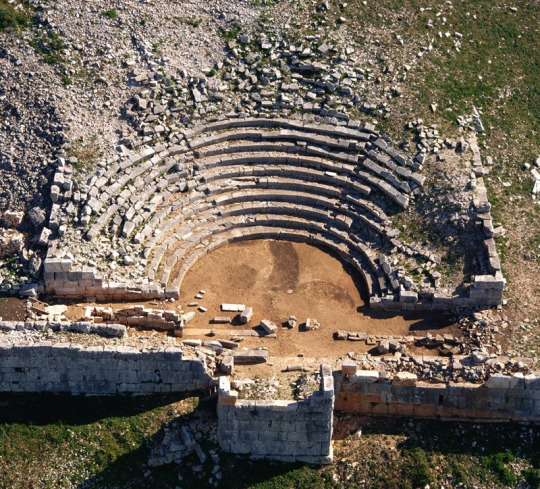
Ancient theatre found in Pleuron
Crete island: Knossos, Gortyna, Militos (there is a place named Milatos nowdays, not sure it’s the same), Lyktos (nearby village named Lyttos), Lykasto, Phaestos, Rytio.

Gortyna.
Rhodes island: Lindos, Ialysos, Kameiros.

Lindos
Symi island, Nisyros island, Krapathos island (nowadays called Karpathos), Kasos island, Kos island, Kalydnes island (nowadays Kalymnos...do I keep it?)

Nisyros island
Halos, Alopi, Trihina, Phthia, Hellas. (Note: Homer now jumps north, towards Thessaly. He already mentioned regions of Phthiotis, however the Ancient Phthia corresponded to modern Phthiotis but also extended very much in the north, across Thessaly. As you also see, Hellas in Homer’s time was nothing more than just another area, although it was one of the areas, alongside Phthia and the rest here, controlled by Achilles. This might have been the reason its name grew so much in significance that eventually overpowered everything else and became the name of the nation and its lands. That happened very soon, maybe within a century or two after the Homeric Epics.)
Pyrasos, Itona, Androna, Pteleos, Fylaki, Feres, Boibeis (mostly known as Karla nowadays), Iaolcos (Iolcos, later Volos through a painfully gradual procedure, do I keep it?), Glaphyres (nowadays Glaphyra)

Fun fact: It is Iaolcos > Iolcos > Yolcos > Yolos > Gholos > Volos. I wish them to get their shit together and go back to Iolcos
Mithoni, Thavmakia, Melivia, Olizona
(Massive Homeric leap to) Limnos island
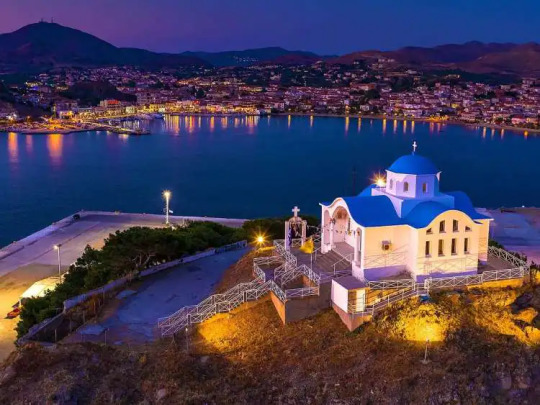
Limnos
(And back again to) Trikki (nowdays called Trikala, do I keep it?), Ithomi, Oehalia.

Trikala
Ormenio, Asterio, Ypereia, mentions the white peaks of Titanos, which must be Othrys mountain, known as the Mountain of the Titans
Argissa, Orthi, Yirtoni, Oloosson (nowadays called Elassona, do I keep it?), Iloni

Elassona
Dodona, referring to it as δυσχείμερον, “which gets bad winters”

Ancient theatre of Dodona
And lastly,
Magnesia: Mount Pelion, characterized by Homer as εινοσíφυλλον, densely-leaved, meaning with dense forests. (Note: Homer does this weird thing, where he says that the Magnetes joined from Mt Pelion, however he has already mentioned several Magnetan locations including Iolcos, Feres, Pteleos etc. Then he makes a giant leap to the east to randomly include Limnos island, then he returns west of Magnesia, to the regions of Larisa and Trikala all the way to the outskirts of Epirus (Dodona) and then he suddenly returns to Magnesia and closes off with Pelion. Beats me.)

In Mt Pelion
Below is a map with all mentioned regions and their leaders in English.

Map from Greek mythology link
#greece#europe#iliad#homer#trojan war#greek mythology#greek history#ancient greece#long post#long text
130 notes
·
View notes
Text

@starspangledbigbang - Thank you!
Title: Not In The Answer But The Question
Artist: @potterspink
Author: @aimmyarrowshigh
Rating: Teen
Pairing: James "Bucky" Barnes/Steve Rogers
Wordcount: 27,100
Main Tags: Drabble Sequence, Alternate Universe, Alternate Universe - Canon Divergence, Captain America Steve Rogers/Modern Bucky Barnes, Shrunkyclunks, Jewish Bucky Barnes, Jewish Character, LGBTQ Jewish Character(s), Jewish Deli Owner Bucky Barnes, Food as a Metaphor for Love, Canon Disabled Character, Disabled Character, Period-Typical Homophobia, Period Typical Attitudes, Period-Typical Ableism, Eugenics, Not Peggy Carter Friendly, Internalized Homophobia, Closeted Character, Post-Serum Steve Rogers, Pre-Serum Steve Rogers, Steve Rogers Needs a Hug
Warnings: No Archive Warnings Apply
Summary: It rankles that his drink was made before he even got a chance to order it.
What if he wanted a change?
What if he were adventurous and bold?
What if he tried something new?
---
Or, Steve Rogers shakes up his gray daily routine in 2014 by going back home to Vinegar Hill. To his surprise, the Jewish deli he used to frequent with Arnie is still standing.
And Steve's whole life changes again.
#not in the answer but the question#star spangled mini bang#star spangled big bang#stucky fanfiction#stucky fic#fandom#fanfiction#my fic
133 notes
·
View notes
Note
What's the funniest or craziest AU idea you've ever come up with?
Have you noticed your style change over time?
12. What's the funniest or craziest AU idea you've ever come up with?
Every come up with or ever posted? 😆
There's a few really wild ones still in my docs (West World style AU but Xadians are robots because robots are cool, regency stuff, Zoom-mates in space) but maybe from my posted stuff it's probably between Aussie backpackers road trip adventure, Road to Nowhere (which I blame you for, Arnie!) and Lawyer Rayla and Graphic Designer Callum modern AU, Zoom-mates.
15. Have you noticed your style change over time?
Oh, definitely. I'd like to think I've got better at conveying emotion and inner thoughts as I've written more. Whenever I read my earlier stuff (yikes), I do notice that difference in particular. I've also found I'm better at holding a POV. There was a lot of head hopping back in the day 😅
I find it especially obvious with my long fics too. The beginning of Zoom-mates or Purgatory fell quite different to the more recent chapters. Which is part of the stall in posting the final chapter of Zoom-mates. I'm editing the earlier stuff before I go ahead and mark it as "complete".
Fandom Ask Game!
8 notes
·
View notes
Text
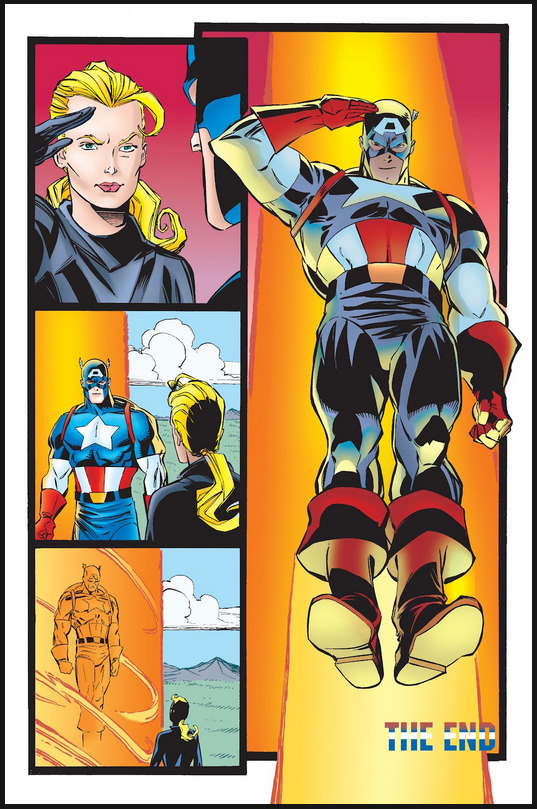
And so, with that, we conclude Captain America Vol 1. (1968-1996)
I'll give a short sum up for anyone who doesn't want to jump below the cut.
This volume is a classic. A 30 year epic that prospered under the hands of some of the best in the business and under the mind of one creative genius in particular who shaped and defined our understanding of one of the greatest characters in the Marvel canon. From the heaving ruckus of the Marvel 60s to the stumbling aftermath of the 90s Dark Age, Captain America shared some of the greatest moments, stories and emotions that you could ever pick off a rack.
I thought I appreciated Cap before. I know much, MUCH better now.
If you're interested in my thoughts on breaking the book down into eras, or want a sneak peak at the next Marvel book on the list. Peek below.
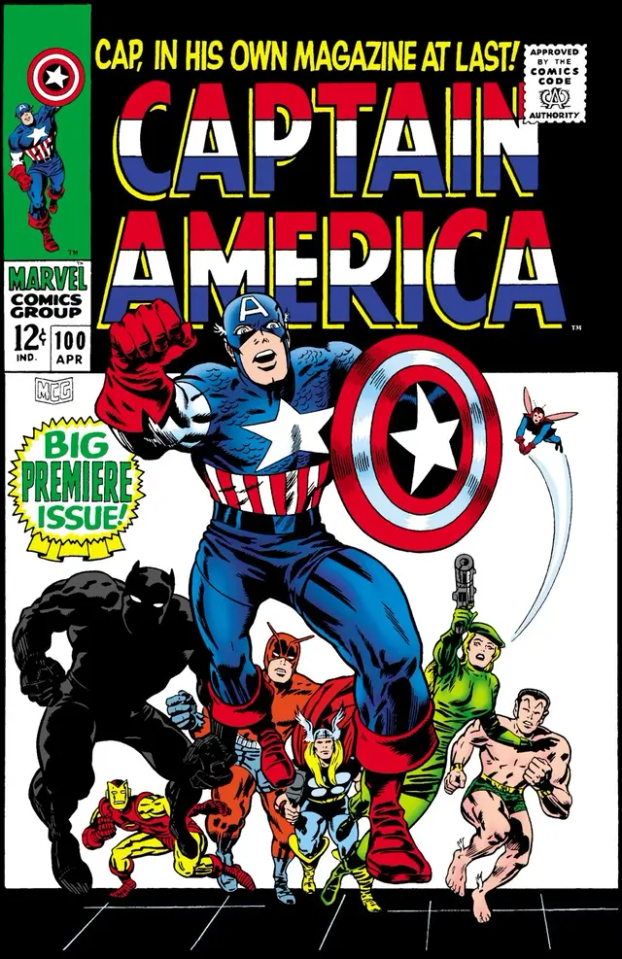
ERA 1, THE SIXTIES:
What can even be SAID about Marvel in the 60s? A constant flooding river of new ideas tossed thick and fast one right after the other in a verbose style that we joke on because we love it. This was a foundational stepping stone of the modern comic book and Captain America is no exception.
Weird science, kirby dots, story straining with a countercultural need to be about something, to turn into something people had never seen before and yet still with a casual familiarity that mad the bullpen feel like a gaggle of college yucksters making it up as they went along.
Often imitated, never duplicated, Captain America in the 60s had about 5 too many Sleeper storylines but an energy that kept me hopping along gladly.

ERA 2, THE FALCON:
Words can hardly describe the breath of fresh air that Sam Wilson AKA The Falcon represented. Cap in the 60s could on run on that early Marvel energy for so long before the Bronze Age crept in and it needed something new, something modern, something that gave the stories some meat to sink into.
Sam Wilson was that and more, a new perspective to every story that kept Captain America honest in how his symbol was viewed and accepted from the ground up by marginalized communities, not to mention someone who could bounce ideas and banter off Steve in every sense.
There's a reason they become one of, if not THE enduring duo of equals in Marvel's canon. Captain America and The Falcon will always have a special resonance to anyone who knows them and this run getting it right the first time is why. Plus, cute birb.

ERA 3, THE BROOKLYN ERA:
With the 80s came a new style, a new grit and reality that came with New York's growth or degeneration depending on how you look at it. Urban sprawl and smog became a constant backdrop and ideas of street crime and urban decay become frightening realities for the residents. So Captain America was forced to confront and integrate himself into that new reality.
He got an apartment, he got a job, he got a girlfriend, he lived in a tenement with people who lived and worked and toiled the same way he did. It's the closest he's ever come to being a Spider-Man style street level hero, fighting the ills of a world that feels real and tactile all around him.
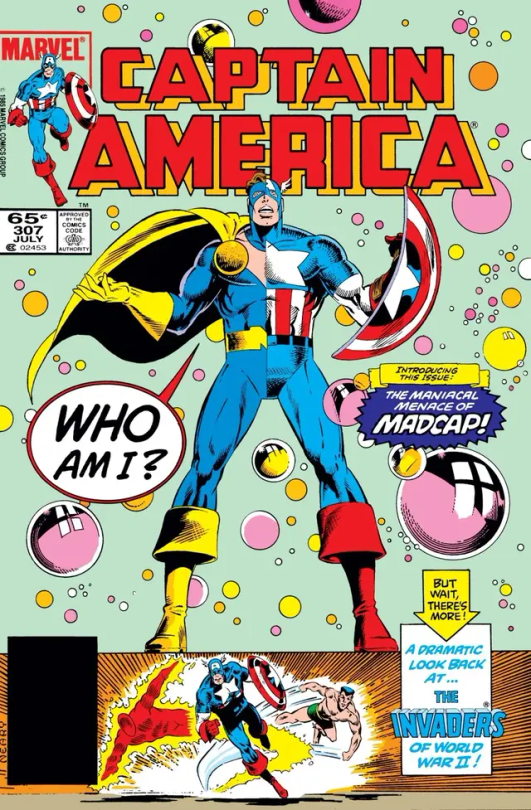
ERA 4, EARLY GRUENWALD:
Now we get to the core of this volume, a single writer and creative that would steer the ship of defining Captain America to the largest extent since his original creators. Mark Gruenwald. A writer who had every idea of how one examined, deconstructed, reconstructed and puzzled with the inherent questions and contradictions inherent in the Sentinel of Liberty. Never does the comic go any length of time without making Cap question who he is and what his purpose is.
It's an era that feels like nothing so much as building momentum, creating an engine to tell stories about a fascinating man and the fascinating people around him, never one to shy away from beloved secondary heroes like Nomad, D-Man and Steve's supporting cast like Bernie Rosenthal or Arnie Roth.

ERA 5, THE JOHN WALKER ERA:
Gruenwald's masterstroke, making Captain America look a modern, cynical world in the eye and ask "who am I, what is my purpose, and what does my symbol mean in a world where freedom and America are not synonymous terms."
Not content to JUST look at that through Steve's eyes, the character of John Walker (Later USAgent) is a dark reflection of Steve that asks him what the consequences would be if his patriotism become jingoism by even one degree over the line. Forcing Steve to define for himself what kind of American ideal he is fighting to protect and what he's willing to sacrifice to back it up when the American Dream and the American Reality couldn't be further apart.

ERA 6, LATER GRUENWALD:
Established with a world class storyline under its belt and nothing left to do but hit the gas and see where it goes, the later Gruenwald era is an expression of the joyous fun that can be taken from a comic that takes itself dramatically but not too seriously. New villains, new twists and pulling old favorites out of mothballs it's a comic that can go anywhere and do anything under an established writer who knows the character like the back of his hand.
The Bloodstone Hunt, Capwolf, Superia. The kind of consistently good storytelling you can only get from a comic that has comfortably gotten into a once in a lifetime kind of groove.
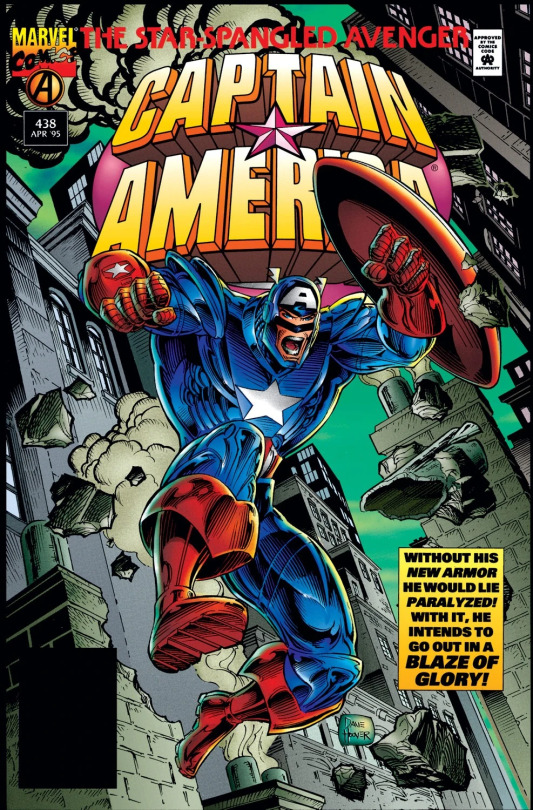
ERA 7, THE @#$%^& 90S:
Like any comic that runs long enough in certain period of time, any good groove is going to run head first into the 90s and end up breaking its nose. I won't lie or sugarcoat it in the name of preserving the book's legacy. The armor storyline and everything surrounding it is ROUGH. The art is ugly, the power armor is dumb and the entire series seems content to wallow in a sense of its own cleverness for examining Cap physically in ways Gruenwald topped 100x over by taking the character apart mentally and emotionally.
I WILL say however, that if you honestly meet this era's emotions on their level, if you're able to get past its flaws, you find that that Gruenwald spark is still right where it was. The new additions, Free Spirit and Jack Flag show promise in the mold of Cap's partners of old and the issue where Cap confronts his own mortality is truly poignant.
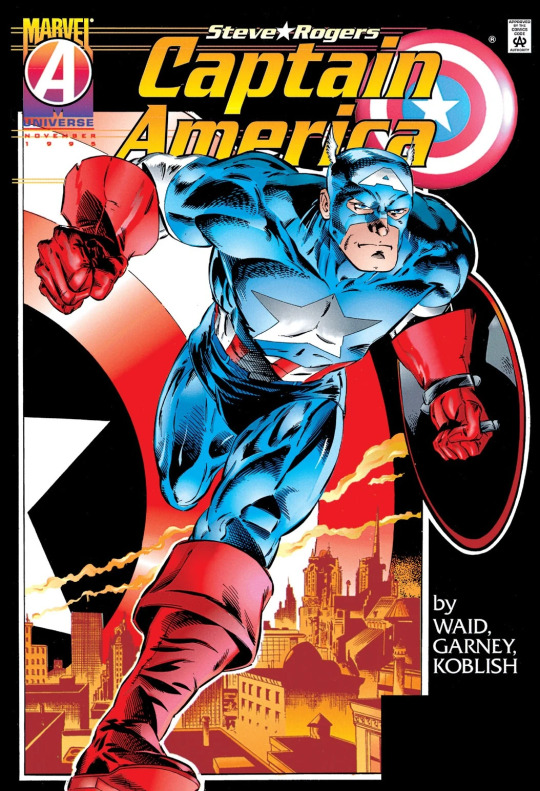
ERA 8, CURTAIN CALL:
Outside of the helm of Gruenwald for the first time in more than 10 years, it's easy to see that the series can't last too much longer in its current form. These issues are all about setting up something new, forcing Cap out of the comfortable spot he's made for himself and confronting an oncoming millennium with the sobering realization that this continuous stream must come to an end to plant something new. Returns of old concepts but with a millennial sheen that gives a hope for the future, it truly feels like the passing of the torch from the old guard to a new one that would take on the Event Comics era and the modern Marvel landscape one way or the other.

CONCLUSION, A LIVING LEGEND:
Captain America is a classic character. We all know it however as a fixture of the universe's main superhero team it's often hard to really frame him in your mind as a character in his own right with his own, independent stories to tell and a timeline that's rich and begging to be mined outside of The Avengers.
Gruenwald forged a new path for Cap, dozens of other creators from 3 decades of Marvel comics reaching in to lend a hand to the tapestry of one of the true legends of comics. A story that twists, turned and sometimes stumbled but never the less kept itself to one, truly unalterable standard.
Legendary.
For those of you interesting in what Marvel book comes along next...Follow me on a journey to the Hyborean Age.

11 notes
·
View notes